Cost Accounting and Management Principles
VerifiedAdded on 2020/01/28
|20
|5348
|89
Literature Review
AI Summary
This assignment delves into the core concepts of cost accounting and management. It examines various costing systems, including standard costs and variance analysis, highlighting their application in product costing and performance evaluation. The assignment also explores different budgeting methods, such as zero-based budgeting and continuous budgeting, analyzing their advantages and limitations in organizational financial planning. Additionally, it investigates the diverse managerial uses of accounting information for decision-making and strategic planning within organizations.
Contribute Materials
Your contribution can guide someone’s learning journey. Share your
documents today.

MANAGEMENT ACCOUNTING
Secure Best Marks with AI Grader
Need help grading? Try our AI Grader for instant feedback on your assignments.
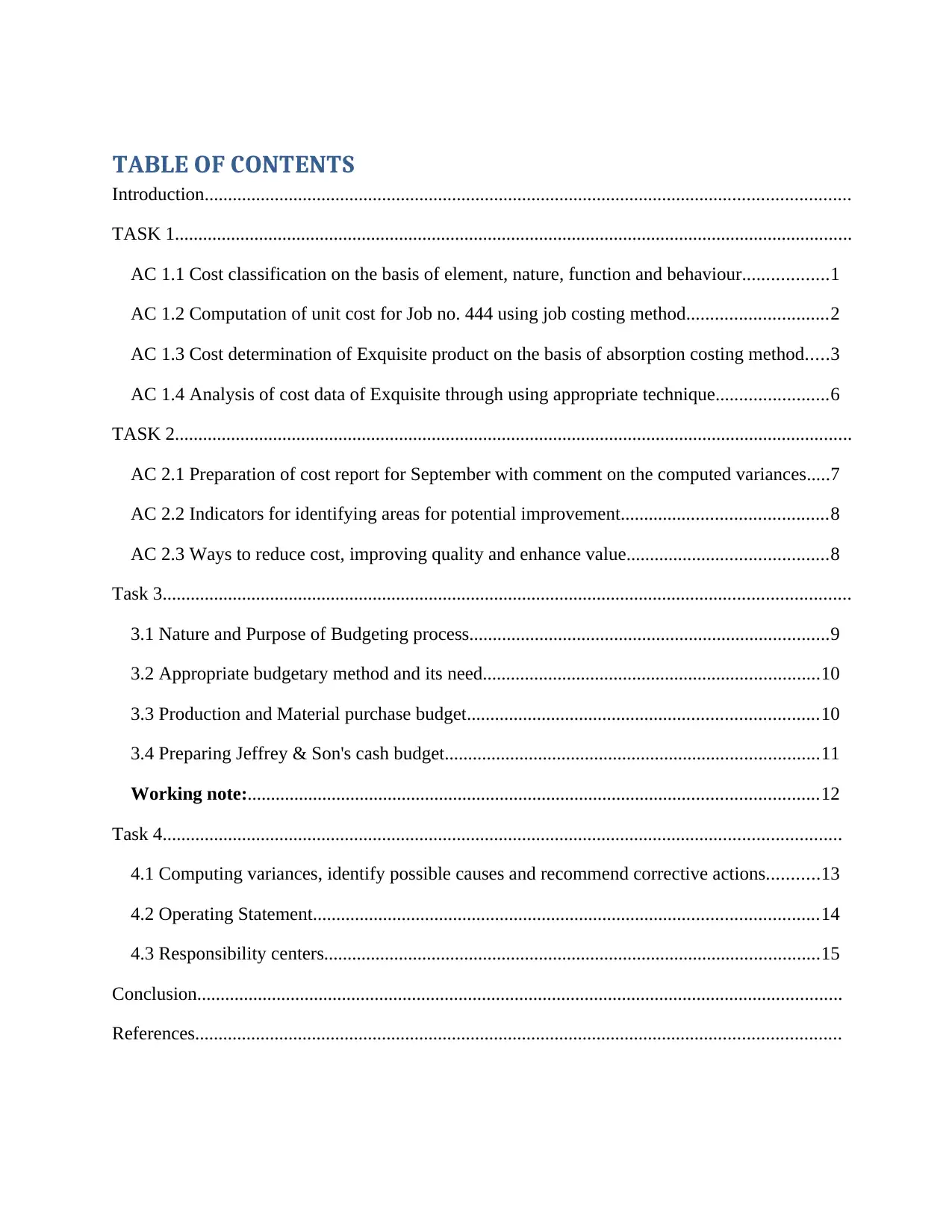
TABLE OF CONTENTS
Introduction..........................................................................................................................................
TASK 1.................................................................................................................................................
AC 1.1 Cost classification on the basis of element, nature, function and behaviour..................1
AC 1.2 Computation of unit cost for Job no. 444 using job costing method..............................2
AC 1.3 Cost determination of Exquisite product on the basis of absorption costing method.....3
AC 1.4 Analysis of cost data of Exquisite through using appropriate technique........................6
TASK 2.................................................................................................................................................
AC 2.1 Preparation of cost report for September with comment on the computed variances.....7
AC 2.2 Indicators for identifying areas for potential improvement............................................8
AC 2.3 Ways to reduce cost, improving quality and enhance value...........................................8
Task 3...................................................................................................................................................
3.1 Nature and Purpose of Budgeting process.............................................................................9
3.2 Appropriate budgetary method and its need........................................................................10
3.3 Production and Material purchase budget...........................................................................10
3.4 Preparing Jeffrey & Son's cash budget................................................................................11
Working note:..........................................................................................................................12
Task 4.................................................................................................................................................
4.1 Computing variances, identify possible causes and recommend corrective actions...........13
4.2 Operating Statement............................................................................................................14
4.3 Responsibility centers..........................................................................................................15
Conclusion..........................................................................................................................................
References..........................................................................................................................................
Introduction..........................................................................................................................................
TASK 1.................................................................................................................................................
AC 1.1 Cost classification on the basis of element, nature, function and behaviour..................1
AC 1.2 Computation of unit cost for Job no. 444 using job costing method..............................2
AC 1.3 Cost determination of Exquisite product on the basis of absorption costing method.....3
AC 1.4 Analysis of cost data of Exquisite through using appropriate technique........................6
TASK 2.................................................................................................................................................
AC 2.1 Preparation of cost report for September with comment on the computed variances.....7
AC 2.2 Indicators for identifying areas for potential improvement............................................8
AC 2.3 Ways to reduce cost, improving quality and enhance value...........................................8
Task 3...................................................................................................................................................
3.1 Nature and Purpose of Budgeting process.............................................................................9
3.2 Appropriate budgetary method and its need........................................................................10
3.3 Production and Material purchase budget...........................................................................10
3.4 Preparing Jeffrey & Son's cash budget................................................................................11
Working note:..........................................................................................................................12
Task 4.................................................................................................................................................
4.1 Computing variances, identify possible causes and recommend corrective actions...........13
4.2 Operating Statement............................................................................................................14
4.3 Responsibility centers..........................................................................................................15
Conclusion..........................................................................................................................................
References..........................................................................................................................................
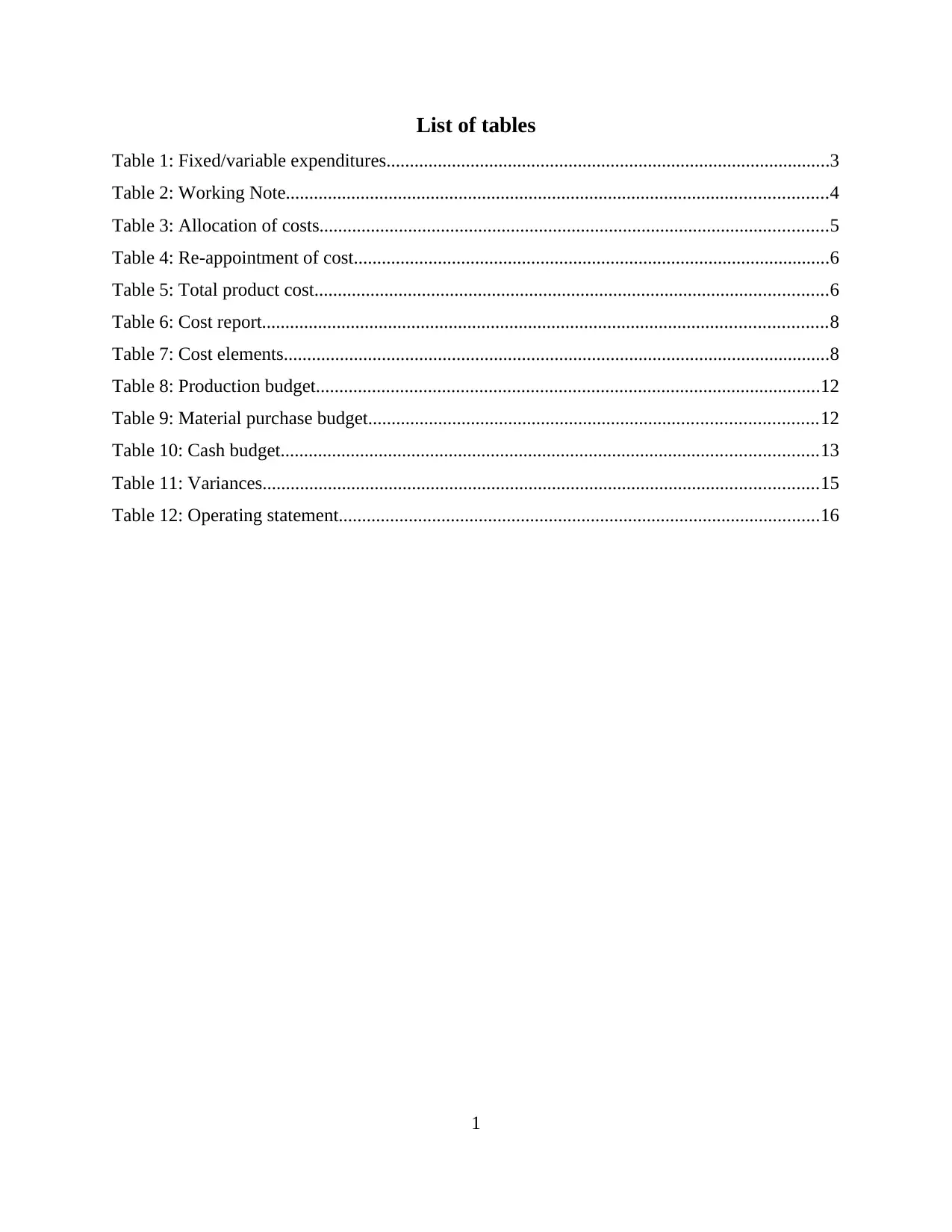
List of tables
Table 1: Fixed/variable expenditures...............................................................................................3
Table 2: Working Note....................................................................................................................4
Table 3: Allocation of costs.............................................................................................................5
Table 4: Re-appointment of cost......................................................................................................6
Table 5: Total product cost..............................................................................................................6
Table 6: Cost report.........................................................................................................................8
Table 7: Cost elements.....................................................................................................................8
Table 8: Production budget............................................................................................................12
Table 9: Material purchase budget................................................................................................12
Table 10: Cash budget...................................................................................................................13
Table 11: Variances.......................................................................................................................15
Table 12: Operating statement.......................................................................................................16
1
Table 1: Fixed/variable expenditures...............................................................................................3
Table 2: Working Note....................................................................................................................4
Table 3: Allocation of costs.............................................................................................................5
Table 4: Re-appointment of cost......................................................................................................6
Table 5: Total product cost..............................................................................................................6
Table 6: Cost report.........................................................................................................................8
Table 7: Cost elements.....................................................................................................................8
Table 8: Production budget............................................................................................................12
Table 9: Material purchase budget................................................................................................12
Table 10: Cash budget...................................................................................................................13
Table 11: Variances.......................................................................................................................15
Table 12: Operating statement.......................................................................................................16
1
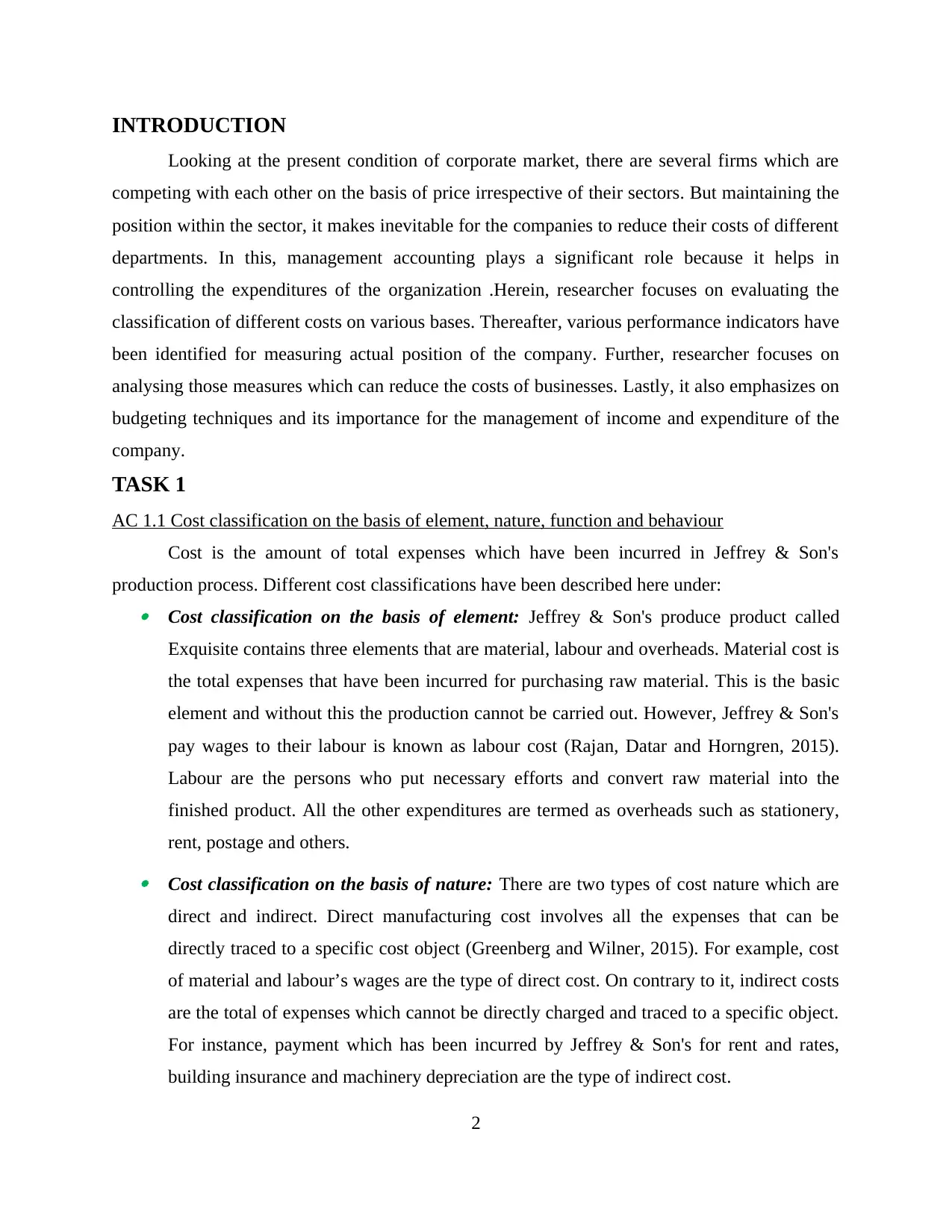
INTRODUCTION
Looking at the present condition of corporate market, there are several firms which are
competing with each other on the basis of price irrespective of their sectors. But maintaining the
position within the sector, it makes inevitable for the companies to reduce their costs of different
departments. In this, management accounting plays a significant role because it helps in
controlling the expenditures of the organization .Herein, researcher focuses on evaluating the
classification of different costs on various bases. Thereafter, various performance indicators have
been identified for measuring actual position of the company. Further, researcher focuses on
analysing those measures which can reduce the costs of businesses. Lastly, it also emphasizes on
budgeting techniques and its importance for the management of income and expenditure of the
company.
TASK 1
AC 1.1 Cost classification on the basis of element, nature, function and behaviour
Cost is the amount of total expenses which have been incurred in Jeffrey & Son's
production process. Different cost classifications have been described here under: Cost classification on the basis of element: Jeffrey & Son's produce product called
Exquisite contains three elements that are material, labour and overheads. Material cost is
the total expenses that have been incurred for purchasing raw material. This is the basic
element and without this the production cannot be carried out. However, Jeffrey & Son's
pay wages to their labour is known as labour cost (Rajan, Datar and Horngren, 2015).
Labour are the persons who put necessary efforts and convert raw material into the
finished product. All the other expenditures are termed as overheads such as stationery,
rent, postage and others. Cost classification on the basis of nature: There are two types of cost nature which are
direct and indirect. Direct manufacturing cost involves all the expenses that can be
directly traced to a specific cost object (Greenberg and Wilner, 2015). For example, cost
of material and labour’s wages are the type of direct cost. On contrary to it, indirect costs
are the total of expenses which cannot be directly charged and traced to a specific object.
For instance, payment which has been incurred by Jeffrey & Son's for rent and rates,
building insurance and machinery depreciation are the type of indirect cost.
2
Looking at the present condition of corporate market, there are several firms which are
competing with each other on the basis of price irrespective of their sectors. But maintaining the
position within the sector, it makes inevitable for the companies to reduce their costs of different
departments. In this, management accounting plays a significant role because it helps in
controlling the expenditures of the organization .Herein, researcher focuses on evaluating the
classification of different costs on various bases. Thereafter, various performance indicators have
been identified for measuring actual position of the company. Further, researcher focuses on
analysing those measures which can reduce the costs of businesses. Lastly, it also emphasizes on
budgeting techniques and its importance for the management of income and expenditure of the
company.
TASK 1
AC 1.1 Cost classification on the basis of element, nature, function and behaviour
Cost is the amount of total expenses which have been incurred in Jeffrey & Son's
production process. Different cost classifications have been described here under: Cost classification on the basis of element: Jeffrey & Son's produce product called
Exquisite contains three elements that are material, labour and overheads. Material cost is
the total expenses that have been incurred for purchasing raw material. This is the basic
element and without this the production cannot be carried out. However, Jeffrey & Son's
pay wages to their labour is known as labour cost (Rajan, Datar and Horngren, 2015).
Labour are the persons who put necessary efforts and convert raw material into the
finished product. All the other expenditures are termed as overheads such as stationery,
rent, postage and others. Cost classification on the basis of nature: There are two types of cost nature which are
direct and indirect. Direct manufacturing cost involves all the expenses that can be
directly traced to a specific cost object (Greenberg and Wilner, 2015). For example, cost
of material and labour’s wages are the type of direct cost. On contrary to it, indirect costs
are the total of expenses which cannot be directly charged and traced to a specific object.
For instance, payment which has been incurred by Jeffrey & Son's for rent and rates,
building insurance and machinery depreciation are the type of indirect cost.
2
Paraphrase This Document
Need a fresh take? Get an instant paraphrase of this document with our AI Paraphraser

Cost classification on the basis of function: Production, administrative and selling as
well as distribution department costs are the types of function based on classification.
Total expenditures incurred for producing Exquisite such as factory lighting, rent and
unproductive wages are the types of production cost. However, office rent, stationery,
postage and photocopier charges are known as administrative cost of Jeffrey & Son's.
Further, the company has to sale Exquisite product in the market therefore, all the
advertisement, marketing and free sample expenses are the types of selling and
distribution cost.
Cost classification on the basis of behaviour: Fixed, variables and semi-variable are the
types of cost behaviour. Fixed expenditures do not get change and remains constant with
the changing production level such as depreciation and insurance. However, variable cost
changes in the same direction as per the production changes (Balakrishnan, Labro and
Soderstrom, 2014). For instance, expenditures for material purchase will increase when
Jeffrey & Son's increase their output level. On the contrary, semi-variable are fixed up to
a certain production level and after that, it changes along with the production for e.g.
electricity and telephone charges.
AC 1.2 Computation of unit cost for Job no. 444 using job costing method
Job costing is a costing technique which accumulates all the variable as well as fixed
expenditures which can be assigned to a specific job (Fisher and Krumwiede, 2015). It is very
suitable costing method for tracking cost of any individual job. Moreover, the technique provides
assistance to analyse and evaluate the job cost to reduce it for the future period.
In context to the present business scenario, Jeffrey & Son's Ltd. Cost data has been given
for job number 444. This job contains small number of units to 200 out of total production
henceforth; job costing method has been applied here for cost computation.
Table 1: Fixed/variable expenditures
Fixed/Variable expenditures Amount
Direct material purchase 40000
Direct wages to labour 54000
Overheads
3
well as distribution department costs are the types of function based on classification.
Total expenditures incurred for producing Exquisite such as factory lighting, rent and
unproductive wages are the types of production cost. However, office rent, stationery,
postage and photocopier charges are known as administrative cost of Jeffrey & Son's.
Further, the company has to sale Exquisite product in the market therefore, all the
advertisement, marketing and free sample expenses are the types of selling and
distribution cost.
Cost classification on the basis of behaviour: Fixed, variables and semi-variable are the
types of cost behaviour. Fixed expenditures do not get change and remains constant with
the changing production level such as depreciation and insurance. However, variable cost
changes in the same direction as per the production changes (Balakrishnan, Labro and
Soderstrom, 2014). For instance, expenditures for material purchase will increase when
Jeffrey & Son's increase their output level. On the contrary, semi-variable are fixed up to
a certain production level and after that, it changes along with the production for e.g.
electricity and telephone charges.
AC 1.2 Computation of unit cost for Job no. 444 using job costing method
Job costing is a costing technique which accumulates all the variable as well as fixed
expenditures which can be assigned to a specific job (Fisher and Krumwiede, 2015). It is very
suitable costing method for tracking cost of any individual job. Moreover, the technique provides
assistance to analyse and evaluate the job cost to reduce it for the future period.
In context to the present business scenario, Jeffrey & Son's Ltd. Cost data has been given
for job number 444. This job contains small number of units to 200 out of total production
henceforth; job costing method has been applied here for cost computation.
Table 1: Fixed/variable expenditures
Fixed/Variable expenditures Amount
Direct material purchase 40000
Direct wages to labour 54000
Overheads
3
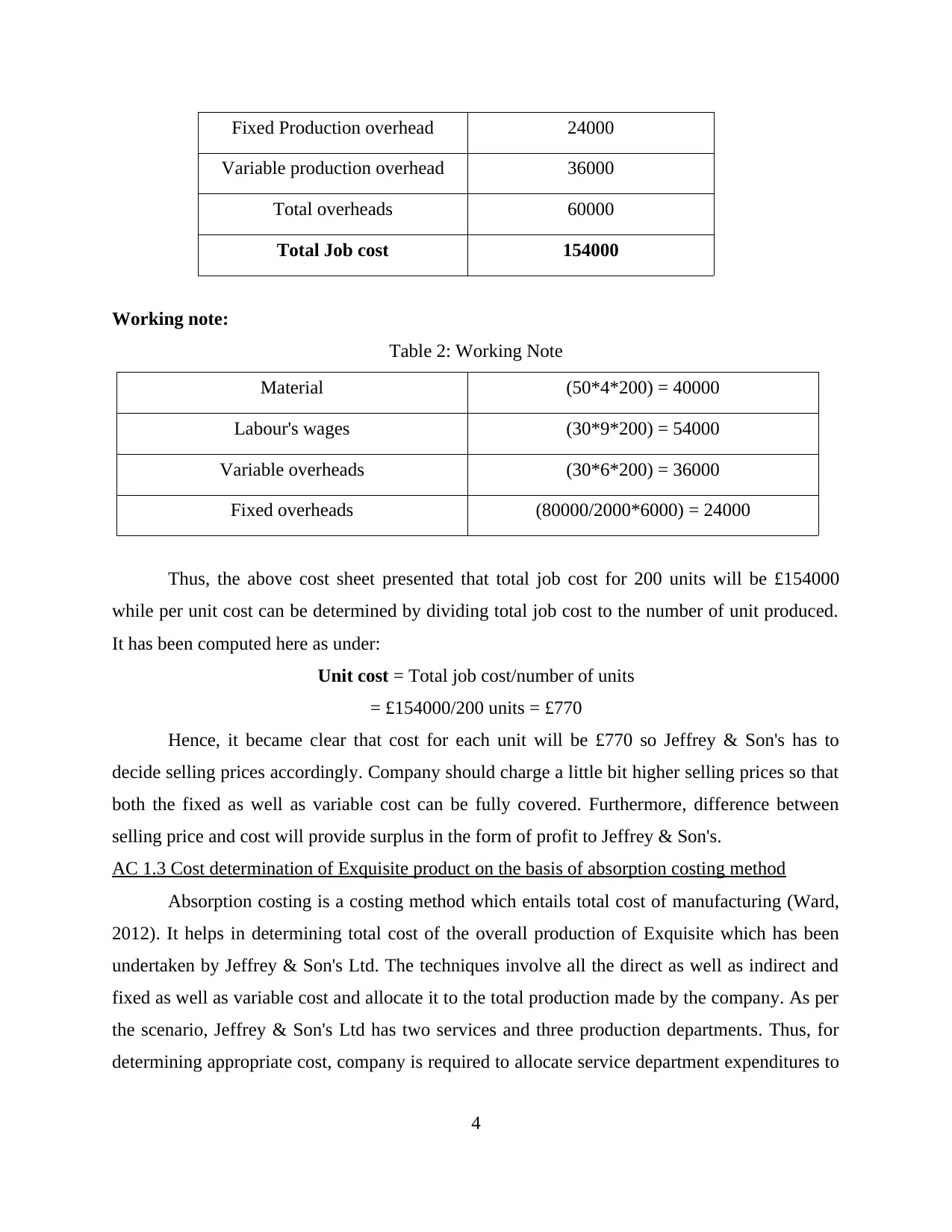
Fixed Production overhead 24000
Variable production overhead 36000
Total overheads 60000
Total Job cost 154000
Working note:
Table 2: Working Note
Material (50*4*200) = 40000
Labour's wages (30*9*200) = 54000
Variable overheads (30*6*200) = 36000
Fixed overheads (80000/2000*6000) = 24000
Thus, the above cost sheet presented that total job cost for 200 units will be £154000
while per unit cost can be determined by dividing total job cost to the number of unit produced.
It has been computed here as under:
Unit cost = Total job cost/number of units
= £154000/200 units = £770
Hence, it became clear that cost for each unit will be £770 so Jeffrey & Son's has to
decide selling prices accordingly. Company should charge a little bit higher selling prices so that
both the fixed as well as variable cost can be fully covered. Furthermore, difference between
selling price and cost will provide surplus in the form of profit to Jeffrey & Son's.
AC 1.3 Cost determination of Exquisite product on the basis of absorption costing method
Absorption costing is a costing method which entails total cost of manufacturing (Ward,
2012). It helps in determining total cost of the overall production of Exquisite which has been
undertaken by Jeffrey & Son's Ltd. The techniques involve all the direct as well as indirect and
fixed as well as variable cost and allocate it to the total production made by the company. As per
the scenario, Jeffrey & Son's Ltd has two services and three production departments. Thus, for
determining appropriate cost, company is required to allocate service department expenditures to
4
Variable production overhead 36000
Total overheads 60000
Total Job cost 154000
Working note:
Table 2: Working Note
Material (50*4*200) = 40000
Labour's wages (30*9*200) = 54000
Variable overheads (30*6*200) = 36000
Fixed overheads (80000/2000*6000) = 24000
Thus, the above cost sheet presented that total job cost for 200 units will be £154000
while per unit cost can be determined by dividing total job cost to the number of unit produced.
It has been computed here as under:
Unit cost = Total job cost/number of units
= £154000/200 units = £770
Hence, it became clear that cost for each unit will be £770 so Jeffrey & Son's has to
decide selling prices accordingly. Company should charge a little bit higher selling prices so that
both the fixed as well as variable cost can be fully covered. Furthermore, difference between
selling price and cost will provide surplus in the form of profit to Jeffrey & Son's.
AC 1.3 Cost determination of Exquisite product on the basis of absorption costing method
Absorption costing is a costing method which entails total cost of manufacturing (Ward,
2012). It helps in determining total cost of the overall production of Exquisite which has been
undertaken by Jeffrey & Son's Ltd. The techniques involve all the direct as well as indirect and
fixed as well as variable cost and allocate it to the total production made by the company. As per
the scenario, Jeffrey & Son's Ltd has two services and three production departments. Thus, for
determining appropriate cost, company is required to allocate service department expenditures to
4
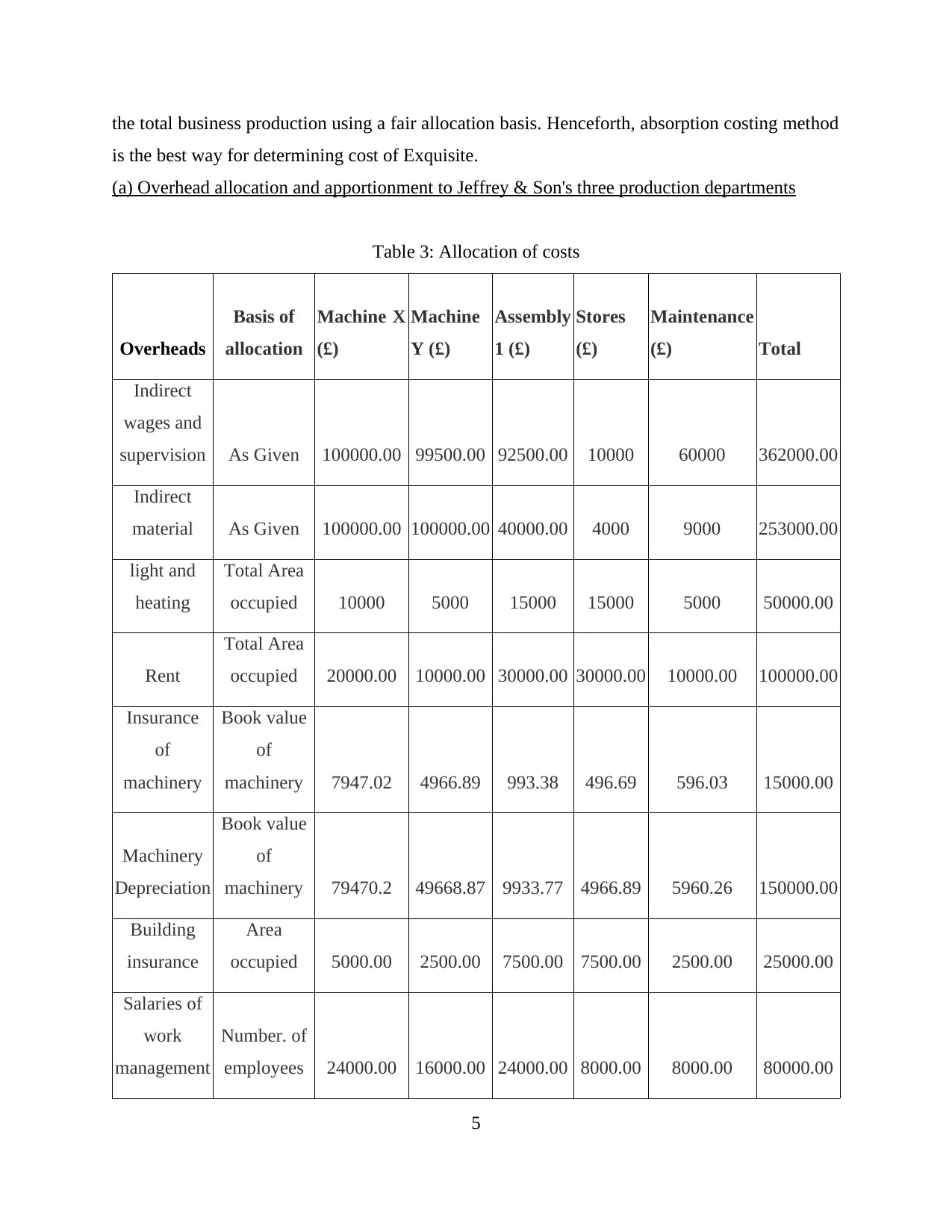
the total business production using a fair allocation basis. Henceforth, absorption costing method
is the best way for determining cost of Exquisite.
(a) Overhead allocation and apportionment to Jeffrey & Son's three production departments
Table 3: Allocation of costs
Overheads
Basis of
allocation
Machine X
(£)
Machine
Y (£)
Assembly
1 (£)
Stores
(£)
Maintenance
(£) Total
Indirect
wages and
supervision As Given 100000.00 99500.00 92500.00 10000 60000 362000.00
Indirect
material As Given 100000.00 100000.00 40000.00 4000 9000 253000.00
light and
heating
Total Area
occupied 10000 5000 15000 15000 5000 50000.00
Rent
Total Area
occupied 20000.00 10000.00 30000.00 30000.00 10000.00 100000.00
Insurance
of
machinery
Book value
of
machinery 7947.02 4966.89 993.38 496.69 596.03 15000.00
Machinery
Depreciation
Book value
of
machinery 79470.2 49668.87 9933.77 4966.89 5960.26 150000.00
Building
insurance
Area
occupied 5000.00 2500.00 7500.00 7500.00 2500.00 25000.00
Salaries of
work
management
Number. of
employees 24000.00 16000.00 24000.00 8000.00 8000.00 80000.00
5
is the best way for determining cost of Exquisite.
(a) Overhead allocation and apportionment to Jeffrey & Son's three production departments
Table 3: Allocation of costs
Overheads
Basis of
allocation
Machine X
(£)
Machine
Y (£)
Assembly
1 (£)
Stores
(£)
Maintenance
(£) Total
Indirect
wages and
supervision As Given 100000.00 99500.00 92500.00 10000 60000 362000.00
Indirect
material As Given 100000.00 100000.00 40000.00 4000 9000 253000.00
light and
heating
Total Area
occupied 10000 5000 15000 15000 5000 50000.00
Rent
Total Area
occupied 20000.00 10000.00 30000.00 30000.00 10000.00 100000.00
Insurance
of
machinery
Book value
of
machinery 7947.02 4966.89 993.38 496.69 596.03 15000.00
Machinery
Depreciation
Book value
of
machinery 79470.2 49668.87 9933.77 4966.89 5960.26 150000.00
Building
insurance
Area
occupied 5000.00 2500.00 7500.00 7500.00 2500.00 25000.00
Salaries of
work
management
Number. of
employees 24000.00 16000.00 24000.00 8000.00 8000.00 80000.00
5
Secure Best Marks with AI Grader
Need help grading? Try our AI Grader for instant feedback on your assignments.
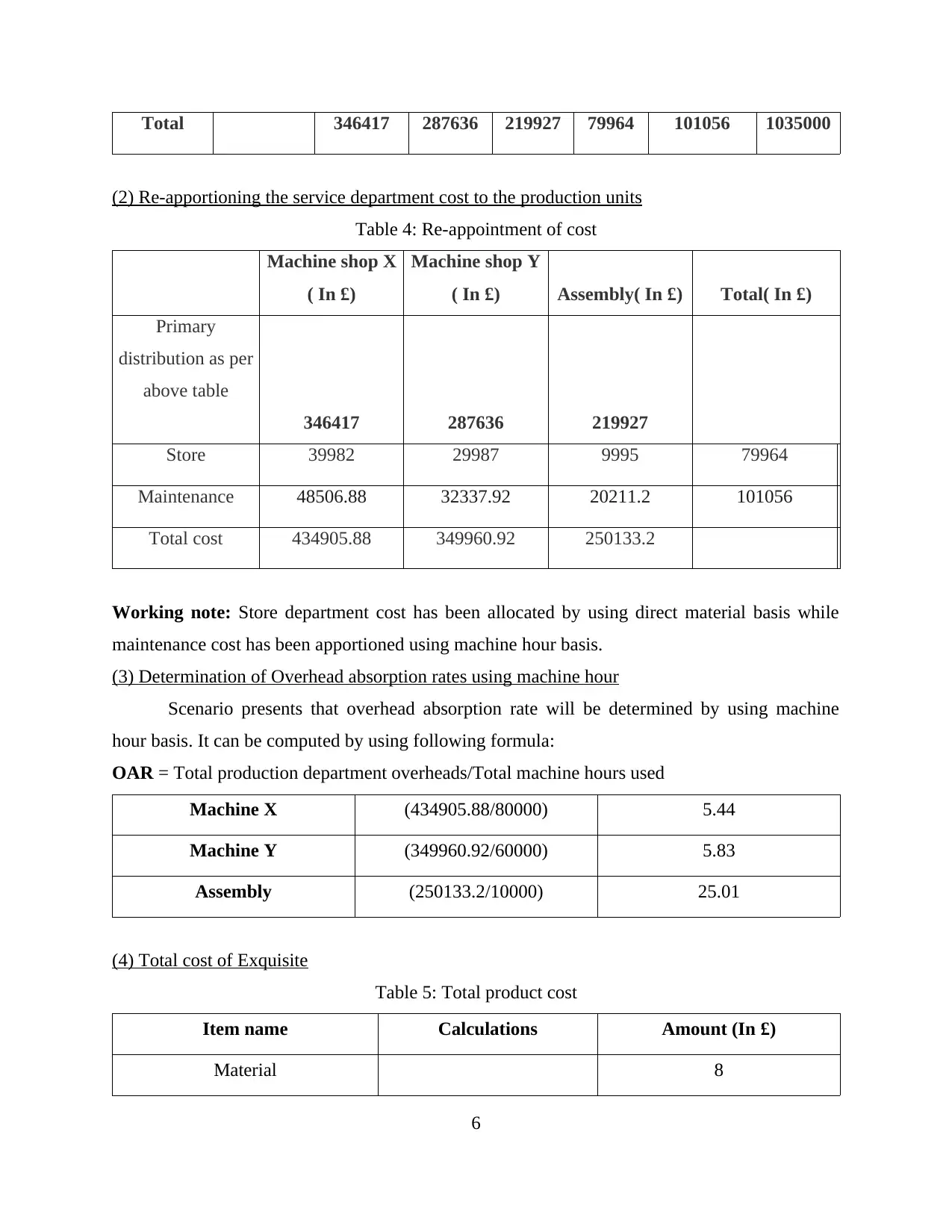
Total 346417 287636 219927 79964 101056 1035000
(2) Re-apportioning the service department cost to the production units
Table 4: Re-appointment of cost
Machine shop X
( In £)
Machine shop Y
( In £) Assembly( In £) Total( In £)
Primary
distribution as per
above table
346417 287636 219927
Store 39982 29987 9995 79964
Maintenance 48506.88 32337.92 20211.2 101056
Total cost 434905.88 349960.92 250133.2
Working note: Store department cost has been allocated by using direct material basis while
maintenance cost has been apportioned using machine hour basis.
(3) Determination of Overhead absorption rates using machine hour
Scenario presents that overhead absorption rate will be determined by using machine
hour basis. It can be computed by using following formula:
OAR = Total production department overheads/Total machine hours used
Machine X (434905.88/80000) 5.44
Machine Y (349960.92/60000) 5.83
Assembly (250133.2/10000) 25.01
(4) Total cost of Exquisite
Table 5: Total product cost
Item name Calculations Amount (In £)
Material 8
6
(2) Re-apportioning the service department cost to the production units
Table 4: Re-appointment of cost
Machine shop X
( In £)
Machine shop Y
( In £) Assembly( In £) Total( In £)
Primary
distribution as per
above table
346417 287636 219927
Store 39982 29987 9995 79964
Maintenance 48506.88 32337.92 20211.2 101056
Total cost 434905.88 349960.92 250133.2
Working note: Store department cost has been allocated by using direct material basis while
maintenance cost has been apportioned using machine hour basis.
(3) Determination of Overhead absorption rates using machine hour
Scenario presents that overhead absorption rate will be determined by using machine
hour basis. It can be computed by using following formula:
OAR = Total production department overheads/Total machine hours used
Machine X (434905.88/80000) 5.44
Machine Y (349960.92/60000) 5.83
Assembly (250133.2/10000) 25.01
(4) Total cost of Exquisite
Table 5: Total product cost
Item name Calculations Amount (In £)
Material 8
6
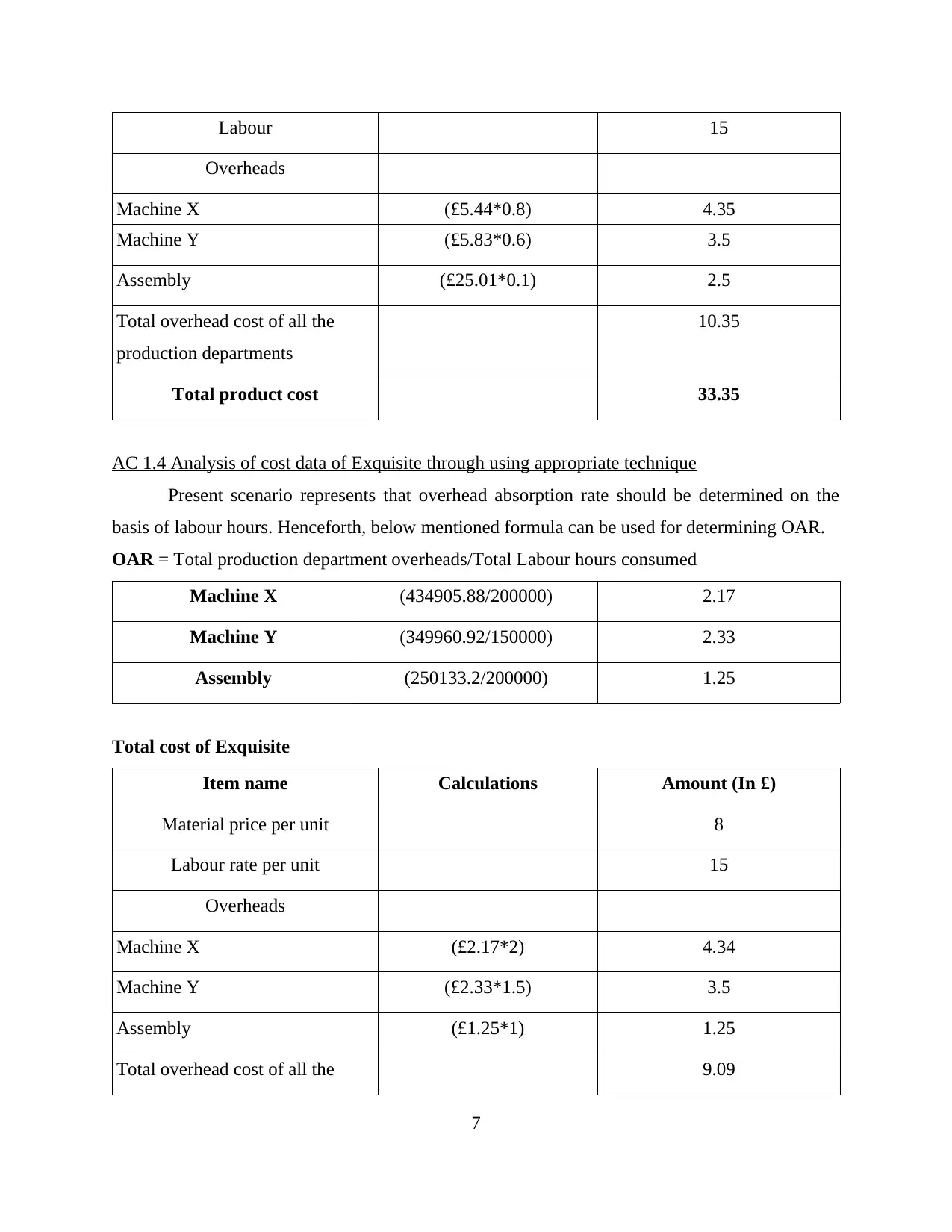
Labour 15
Overheads
Machine X (£5.44*0.8) 4.35
Machine Y (£5.83*0.6) 3.5
Assembly (£25.01*0.1) 2.5
Total overhead cost of all the
production departments
10.35
Total product cost 33.35
AC 1.4 Analysis of cost data of Exquisite through using appropriate technique
Present scenario represents that overhead absorption rate should be determined on the
basis of labour hours. Henceforth, below mentioned formula can be used for determining OAR.
OAR = Total production department overheads/Total Labour hours consumed
Machine X (434905.88/200000) 2.17
Machine Y (349960.92/150000) 2.33
Assembly (250133.2/200000) 1.25
Total cost of Exquisite
Item name Calculations Amount (In £)
Material price per unit 8
Labour rate per unit 15
Overheads
Machine X (£2.17*2) 4.34
Machine Y (£2.33*1.5) 3.5
Assembly (£1.25*1) 1.25
Total overhead cost of all the 9.09
7
Overheads
Machine X (£5.44*0.8) 4.35
Machine Y (£5.83*0.6) 3.5
Assembly (£25.01*0.1) 2.5
Total overhead cost of all the
production departments
10.35
Total product cost 33.35
AC 1.4 Analysis of cost data of Exquisite through using appropriate technique
Present scenario represents that overhead absorption rate should be determined on the
basis of labour hours. Henceforth, below mentioned formula can be used for determining OAR.
OAR = Total production department overheads/Total Labour hours consumed
Machine X (434905.88/200000) 2.17
Machine Y (349960.92/150000) 2.33
Assembly (250133.2/200000) 1.25
Total cost of Exquisite
Item name Calculations Amount (In £)
Material price per unit 8
Labour rate per unit 15
Overheads
Machine X (£2.17*2) 4.34
Machine Y (£2.33*1.5) 3.5
Assembly (£1.25*1) 1.25
Total overhead cost of all the 9.09
7
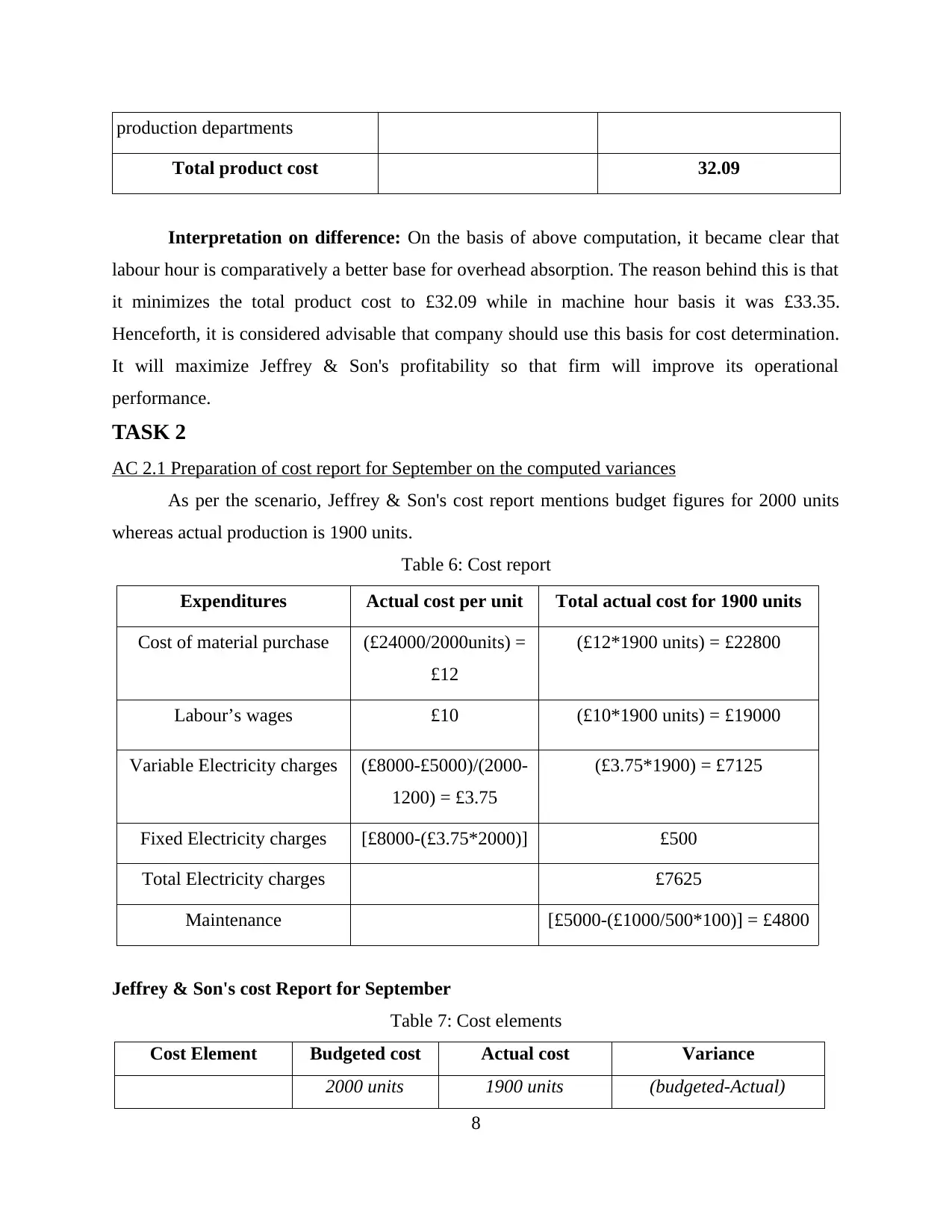
production departments
Total product cost 32.09
Interpretation on difference: On the basis of above computation, it became clear that
labour hour is comparatively a better base for overhead absorption. The reason behind this is that
it minimizes the total product cost to £32.09 while in machine hour basis it was £33.35.
Henceforth, it is considered advisable that company should use this basis for cost determination.
It will maximize Jeffrey & Son's profitability so that firm will improve its operational
performance.
TASK 2
AC 2.1 Preparation of cost report for September on the computed variances
As per the scenario, Jeffrey & Son's cost report mentions budget figures for 2000 units
whereas actual production is 1900 units.
Table 6: Cost report
Expenditures Actual cost per unit Total actual cost for 1900 units
Cost of material purchase (£24000/2000units) =
£12
(£12*1900 units) = £22800
Labour’s wages £10 (£10*1900 units) = £19000
Variable Electricity charges (£8000-£5000)/(2000-
1200) = £3.75
(£3.75*1900) = £7125
Fixed Electricity charges [£8000-(£3.75*2000)] £500
Total Electricity charges £7625
Maintenance [£5000-(£1000/500*100)] = £4800
Jeffrey & Son's cost Report for September
Table 7: Cost elements
Cost Element Budgeted cost Actual cost Variance
2000 units 1900 units (budgeted-Actual)
8
Total product cost 32.09
Interpretation on difference: On the basis of above computation, it became clear that
labour hour is comparatively a better base for overhead absorption. The reason behind this is that
it minimizes the total product cost to £32.09 while in machine hour basis it was £33.35.
Henceforth, it is considered advisable that company should use this basis for cost determination.
It will maximize Jeffrey & Son's profitability so that firm will improve its operational
performance.
TASK 2
AC 2.1 Preparation of cost report for September on the computed variances
As per the scenario, Jeffrey & Son's cost report mentions budget figures for 2000 units
whereas actual production is 1900 units.
Table 6: Cost report
Expenditures Actual cost per unit Total actual cost for 1900 units
Cost of material purchase (£24000/2000units) =
£12
(£12*1900 units) = £22800
Labour’s wages £10 (£10*1900 units) = £19000
Variable Electricity charges (£8000-£5000)/(2000-
1200) = £3.75
(£3.75*1900) = £7125
Fixed Electricity charges [£8000-(£3.75*2000)] £500
Total Electricity charges £7625
Maintenance [£5000-(£1000/500*100)] = £4800
Jeffrey & Son's cost Report for September
Table 7: Cost elements
Cost Element Budgeted cost Actual cost Variance
2000 units 1900 units (budgeted-Actual)
8
Paraphrase This Document
Need a fresh take? Get an instant paraphrase of this document with our AI Paraphraser
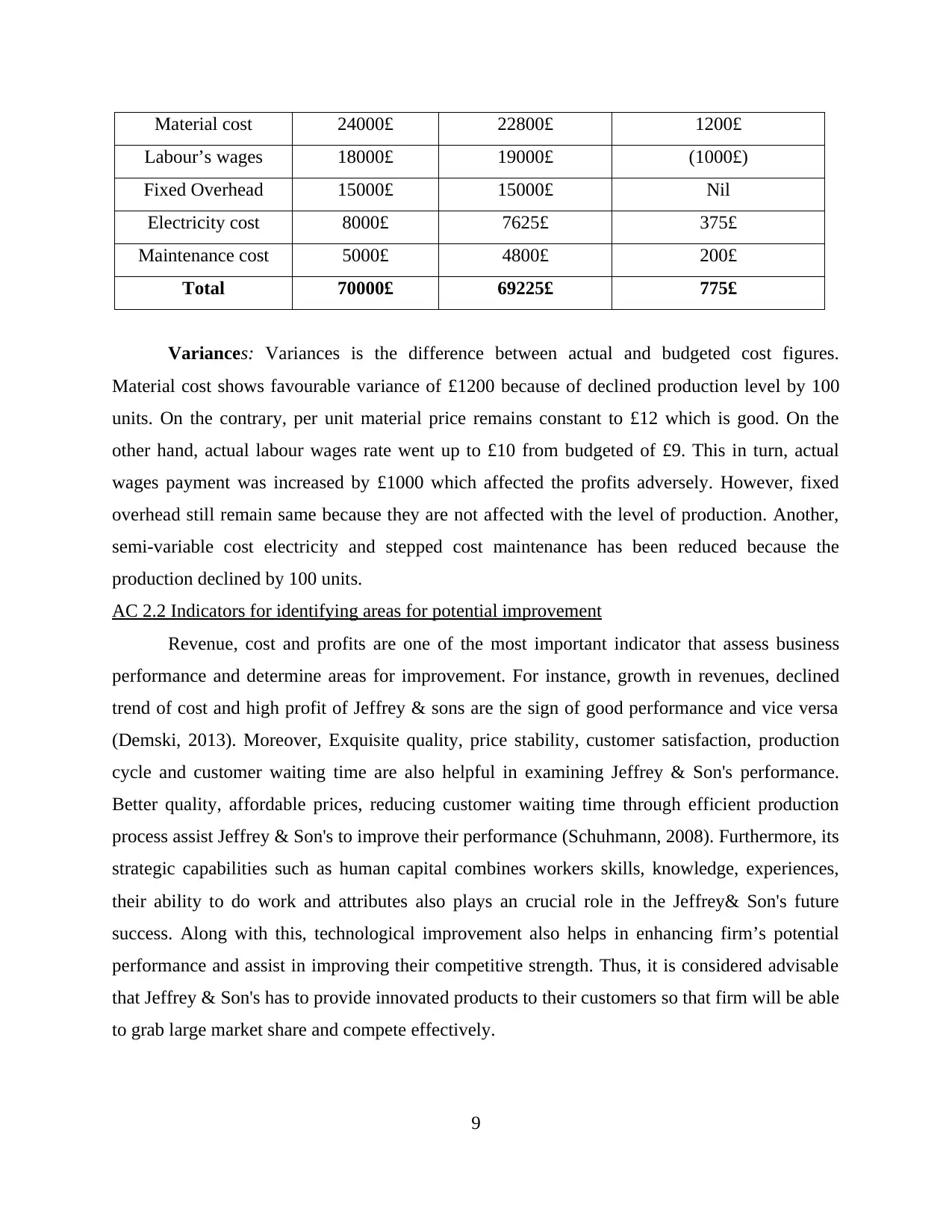
Material cost 24000£ 22800£ 1200£
Labour’s wages 18000£ 19000£ (1000£)
Fixed Overhead 15000£ 15000£ Nil
Electricity cost 8000£ 7625£ 375£
Maintenance cost 5000£ 4800£ 200£
Total 70000£ 69225£ 775£
Variances: Variances is the difference between actual and budgeted cost figures.
Material cost shows favourable variance of £1200 because of declined production level by 100
units. On the contrary, per unit material price remains constant to £12 which is good. On the
other hand, actual labour wages rate went up to £10 from budgeted of £9. This in turn, actual
wages payment was increased by £1000 which affected the profits adversely. However, fixed
overhead still remain same because they are not affected with the level of production. Another,
semi-variable cost electricity and stepped cost maintenance has been reduced because the
production declined by 100 units.
AC 2.2 Indicators for identifying areas for potential improvement
Revenue, cost and profits are one of the most important indicator that assess business
performance and determine areas for improvement. For instance, growth in revenues, declined
trend of cost and high profit of Jeffrey & sons are the sign of good performance and vice versa
(Demski, 2013). Moreover, Exquisite quality, price stability, customer satisfaction, production
cycle and customer waiting time are also helpful in examining Jeffrey & Son's performance.
Better quality, affordable prices, reducing customer waiting time through efficient production
process assist Jeffrey & Son's to improve their performance (Schuhmann, 2008). Furthermore, its
strategic capabilities such as human capital combines workers skills, knowledge, experiences,
their ability to do work and attributes also plays an crucial role in the Jeffrey& Son's future
success. Along with this, technological improvement also helps in enhancing firm’s potential
performance and assist in improving their competitive strength. Thus, it is considered advisable
that Jeffrey & Son's has to provide innovated products to their customers so that firm will be able
to grab large market share and compete effectively.
9
Labour’s wages 18000£ 19000£ (1000£)
Fixed Overhead 15000£ 15000£ Nil
Electricity cost 8000£ 7625£ 375£
Maintenance cost 5000£ 4800£ 200£
Total 70000£ 69225£ 775£
Variances: Variances is the difference between actual and budgeted cost figures.
Material cost shows favourable variance of £1200 because of declined production level by 100
units. On the contrary, per unit material price remains constant to £12 which is good. On the
other hand, actual labour wages rate went up to £10 from budgeted of £9. This in turn, actual
wages payment was increased by £1000 which affected the profits adversely. However, fixed
overhead still remain same because they are not affected with the level of production. Another,
semi-variable cost electricity and stepped cost maintenance has been reduced because the
production declined by 100 units.
AC 2.2 Indicators for identifying areas for potential improvement
Revenue, cost and profits are one of the most important indicator that assess business
performance and determine areas for improvement. For instance, growth in revenues, declined
trend of cost and high profit of Jeffrey & sons are the sign of good performance and vice versa
(Demski, 2013). Moreover, Exquisite quality, price stability, customer satisfaction, production
cycle and customer waiting time are also helpful in examining Jeffrey & Son's performance.
Better quality, affordable prices, reducing customer waiting time through efficient production
process assist Jeffrey & Son's to improve their performance (Schuhmann, 2008). Furthermore, its
strategic capabilities such as human capital combines workers skills, knowledge, experiences,
their ability to do work and attributes also plays an crucial role in the Jeffrey& Son's future
success. Along with this, technological improvement also helps in enhancing firm’s potential
performance and assist in improving their competitive strength. Thus, it is considered advisable
that Jeffrey & Son's has to provide innovated products to their customers so that firm will be able
to grab large market share and compete effectively.
9

AC 2.3 Ways to reduce cost, improving quality and enhance value Cost reduction: Regular monitoring of all the operational activities will help to manage
spending. In context to Jeffrey & Son's, material cost can be reduced through finding best
suppliers who can provide qualitative products at cost effective prices and reduce
material wastage. However, wages cost can be minimized through hiring labours at the
lower piece rate (Campbell and Brown, 2016). In addition, all the other overheads can be
controlled by effectively utilizing and allocating resources and continuous monitoring.
Moreover, large production level also provides benefits of economies of scale and
reduces per unit cost. Quality improvement: It is the most important factor in manufacturing industry. Jeffrey
&Sons can improve Exquisite quality by using good quality of material and innovated
technological process (Goetsch and Davis, 2014). Furthermore, TQM is a technique
which can be used for the overall quality management of company's product.
Enhance corporate value: Growth in shareholders worth, business expansion, large
investment, new product development, improving competitive position, large customer
base, brand loyalty and entering into new markets makes Jeffrey & Son's able to enhance
its business value (Chatterji and Fabrizio, 2014).
TASK 3
3.1 Nature and Purpose of Budgeting process
Nature of Budgeting Process:
By preparing the budget, finance manager of Jeffrey & Son’s focus on gathering all the
required information for preparing suitable and realistic budget (Anderson, 2011). The data can
be related to different departments such as production, sales, marketing etc. which company
possess. Further, all the sources of income are recorded in the budget so as to identify the
potential ways through which company can generate its revenue (Adler, 2013). Further, these
sources can be sales, lease, investment etc. as they are prepared for financial products. In this,
manager predicts the future sales performance of business on the basis of current economic
environment. In addition to this, manager of Jeffrey &Sons can forecast the expenditures with
the help of materials, labours and overheads. Further, by carrying out comparison between
revenue generated and expenditure incurred manager can easily evaluate deficit and surplus
position of the business (Debarishi, 2011). Thereafter, Jeffrey & Son’s managers have to focus
10
spending. In context to Jeffrey & Son's, material cost can be reduced through finding best
suppliers who can provide qualitative products at cost effective prices and reduce
material wastage. However, wages cost can be minimized through hiring labours at the
lower piece rate (Campbell and Brown, 2016). In addition, all the other overheads can be
controlled by effectively utilizing and allocating resources and continuous monitoring.
Moreover, large production level also provides benefits of economies of scale and
reduces per unit cost. Quality improvement: It is the most important factor in manufacturing industry. Jeffrey
&Sons can improve Exquisite quality by using good quality of material and innovated
technological process (Goetsch and Davis, 2014). Furthermore, TQM is a technique
which can be used for the overall quality management of company's product.
Enhance corporate value: Growth in shareholders worth, business expansion, large
investment, new product development, improving competitive position, large customer
base, brand loyalty and entering into new markets makes Jeffrey & Son's able to enhance
its business value (Chatterji and Fabrizio, 2014).
TASK 3
3.1 Nature and Purpose of Budgeting process
Nature of Budgeting Process:
By preparing the budget, finance manager of Jeffrey & Son’s focus on gathering all the
required information for preparing suitable and realistic budget (Anderson, 2011). The data can
be related to different departments such as production, sales, marketing etc. which company
possess. Further, all the sources of income are recorded in the budget so as to identify the
potential ways through which company can generate its revenue (Adler, 2013). Further, these
sources can be sales, lease, investment etc. as they are prepared for financial products. In this,
manager predicts the future sales performance of business on the basis of current economic
environment. In addition to this, manager of Jeffrey &Sons can forecast the expenditures with
the help of materials, labours and overheads. Further, by carrying out comparison between
revenue generated and expenditure incurred manager can easily evaluate deficit and surplus
position of the business (Debarishi, 2011). Thereafter, Jeffrey & Son’s managers have to focus
10
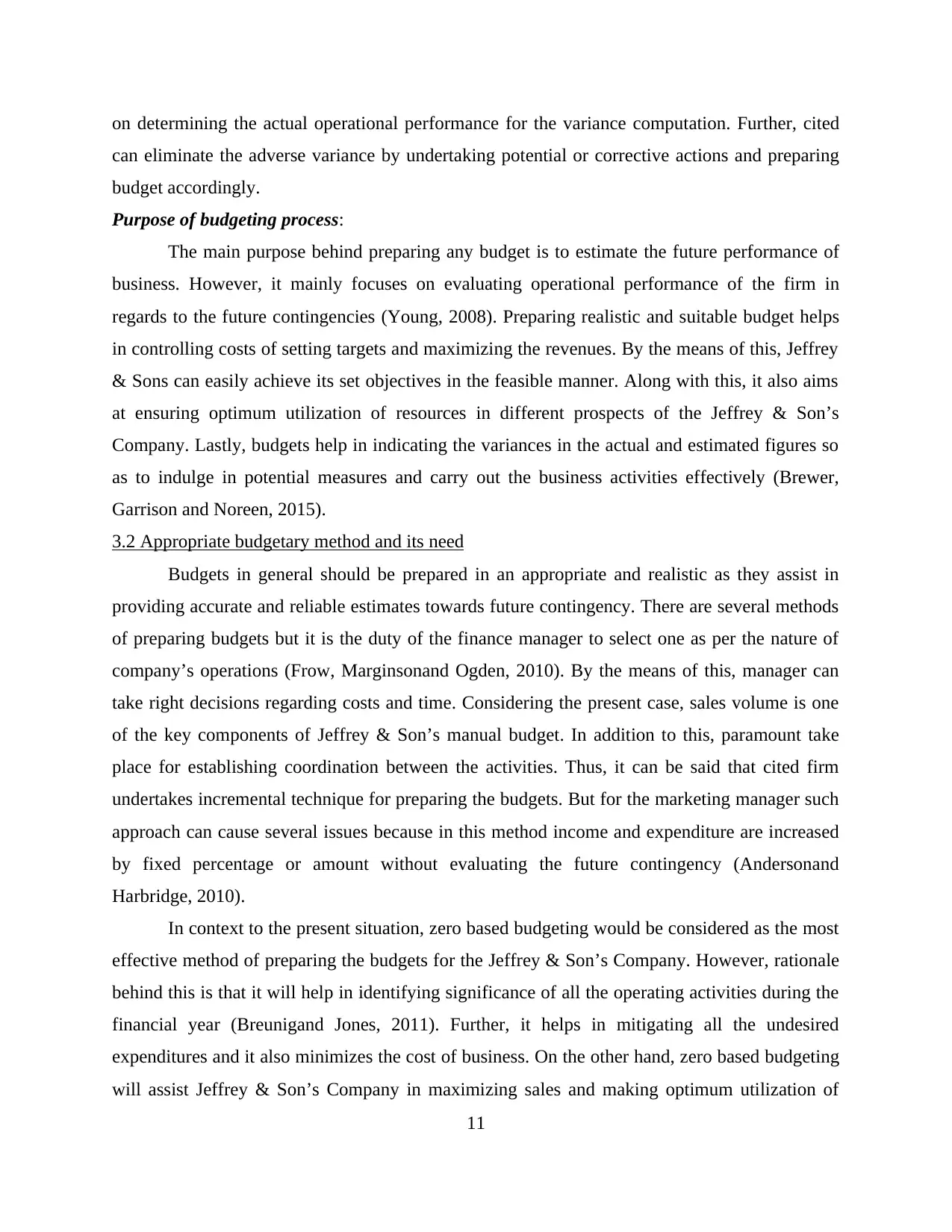
on determining the actual operational performance for the variance computation. Further, cited
can eliminate the adverse variance by undertaking potential or corrective actions and preparing
budget accordingly.
Purpose of budgeting process:
The main purpose behind preparing any budget is to estimate the future performance of
business. However, it mainly focuses on evaluating operational performance of the firm in
regards to the future contingencies (Young, 2008). Preparing realistic and suitable budget helps
in controlling costs of setting targets and maximizing the revenues. By the means of this, Jeffrey
& Sons can easily achieve its set objectives in the feasible manner. Along with this, it also aims
at ensuring optimum utilization of resources in different prospects of the Jeffrey & Son’s
Company. Lastly, budgets help in indicating the variances in the actual and estimated figures so
as to indulge in potential measures and carry out the business activities effectively (Brewer,
Garrison and Noreen, 2015).
3.2 Appropriate budgetary method and its need
Budgets in general should be prepared in an appropriate and realistic as they assist in
providing accurate and reliable estimates towards future contingency. There are several methods
of preparing budgets but it is the duty of the finance manager to select one as per the nature of
company’s operations (Frow, Marginsonand Ogden, 2010). By the means of this, manager can
take right decisions regarding costs and time. Considering the present case, sales volume is one
of the key components of Jeffrey & Son’s manual budget. In addition to this, paramount take
place for establishing coordination between the activities. Thus, it can be said that cited firm
undertakes incremental technique for preparing the budgets. But for the marketing manager such
approach can cause several issues because in this method income and expenditure are increased
by fixed percentage or amount without evaluating the future contingency (Andersonand
Harbridge, 2010).
In context to the present situation, zero based budgeting would be considered as the most
effective method of preparing the budgets for the Jeffrey & Son’s Company. However, rationale
behind this is that it will help in identifying significance of all the operating activities during the
financial year (Breunigand Jones, 2011). Further, it helps in mitigating all the undesired
expenditures and it also minimizes the cost of business. On the other hand, zero based budgeting
will assist Jeffrey & Son’s Company in maximizing sales and making optimum utilization of
11
can eliminate the adverse variance by undertaking potential or corrective actions and preparing
budget accordingly.
Purpose of budgeting process:
The main purpose behind preparing any budget is to estimate the future performance of
business. However, it mainly focuses on evaluating operational performance of the firm in
regards to the future contingencies (Young, 2008). Preparing realistic and suitable budget helps
in controlling costs of setting targets and maximizing the revenues. By the means of this, Jeffrey
& Sons can easily achieve its set objectives in the feasible manner. Along with this, it also aims
at ensuring optimum utilization of resources in different prospects of the Jeffrey & Son’s
Company. Lastly, budgets help in indicating the variances in the actual and estimated figures so
as to indulge in potential measures and carry out the business activities effectively (Brewer,
Garrison and Noreen, 2015).
3.2 Appropriate budgetary method and its need
Budgets in general should be prepared in an appropriate and realistic as they assist in
providing accurate and reliable estimates towards future contingency. There are several methods
of preparing budgets but it is the duty of the finance manager to select one as per the nature of
company’s operations (Frow, Marginsonand Ogden, 2010). By the means of this, manager can
take right decisions regarding costs and time. Considering the present case, sales volume is one
of the key components of Jeffrey & Son’s manual budget. In addition to this, paramount take
place for establishing coordination between the activities. Thus, it can be said that cited firm
undertakes incremental technique for preparing the budgets. But for the marketing manager such
approach can cause several issues because in this method income and expenditure are increased
by fixed percentage or amount without evaluating the future contingency (Andersonand
Harbridge, 2010).
In context to the present situation, zero based budgeting would be considered as the most
effective method of preparing the budgets for the Jeffrey & Son’s Company. However, rationale
behind this is that it will help in identifying significance of all the operating activities during the
financial year (Breunigand Jones, 2011). Further, it helps in mitigating all the undesired
expenditures and it also minimizes the cost of business. On the other hand, zero based budgeting
will assist Jeffrey & Son’s Company in maximizing sales and making optimum utilization of
11
Secure Best Marks with AI Grader
Need help grading? Try our AI Grader for instant feedback on your assignments.
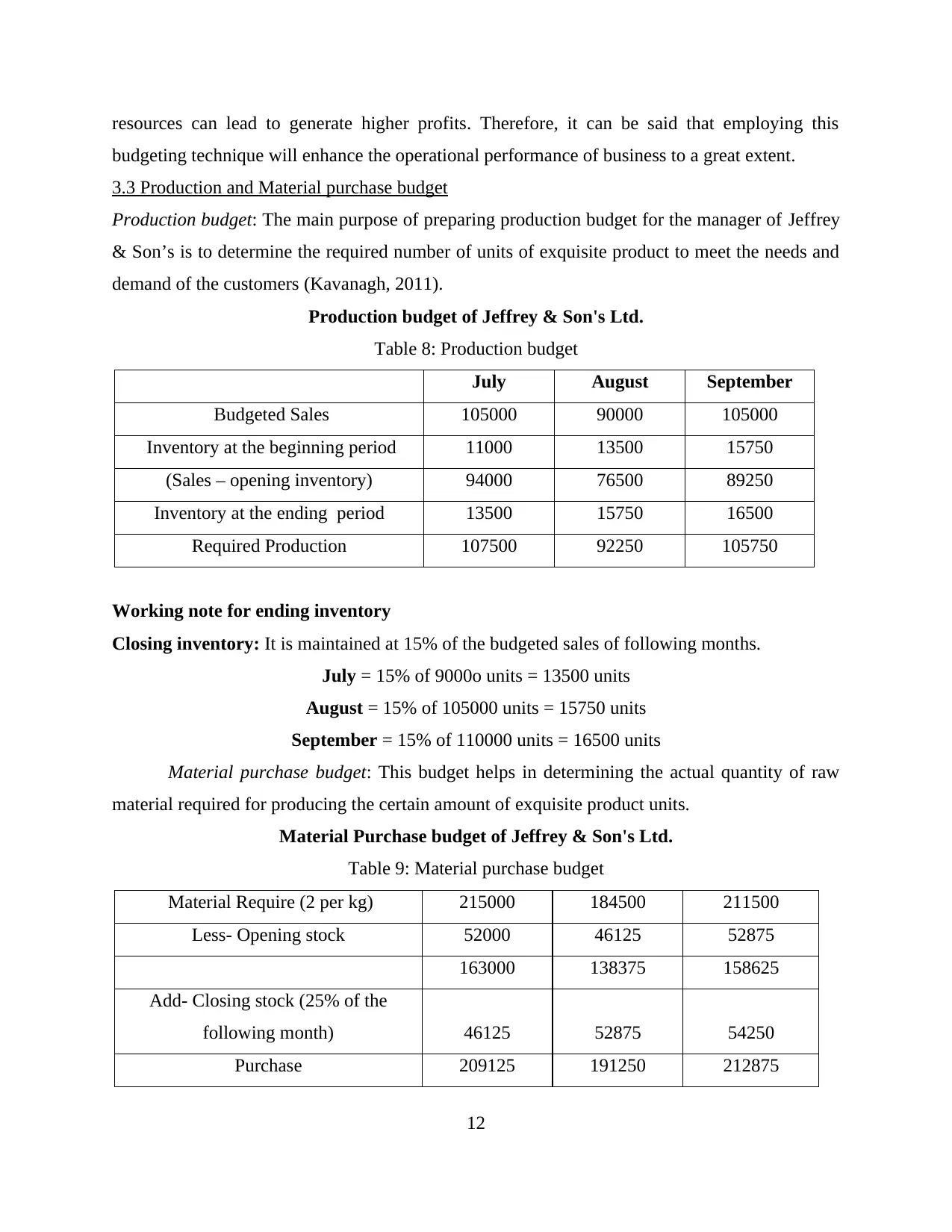
resources can lead to generate higher profits. Therefore, it can be said that employing this
budgeting technique will enhance the operational performance of business to a great extent.
3.3 Production and Material purchase budget
Production budget: The main purpose of preparing production budget for the manager of Jeffrey
& Son’s is to determine the required number of units of exquisite product to meet the needs and
demand of the customers (Kavanagh, 2011).
Production budget of Jeffrey & Son's Ltd.
Table 8: Production budget
July August September
Budgeted Sales 105000 90000 105000
Inventory at the beginning period 11000 13500 15750
(Sales – opening inventory) 94000 76500 89250
Inventory at the ending period 13500 15750 16500
Required Production 107500 92250 105750
Working note for ending inventory
Closing inventory: It is maintained at 15% of the budgeted sales of following months.
July = 15% of 9000o units = 13500 units
August = 15% of 105000 units = 15750 units
September = 15% of 110000 units = 16500 units
Material purchase budget: This budget helps in determining the actual quantity of raw
material required for producing the certain amount of exquisite product units.
Material Purchase budget of Jeffrey & Son's Ltd.
Table 9: Material purchase budget
Material Require (2 per kg) 215000 184500 211500
Less- Opening stock 52000 46125 52875
163000 138375 158625
Add- Closing stock (25% of the
following month) 46125 52875 54250
Purchase 209125 191250 212875
12
budgeting technique will enhance the operational performance of business to a great extent.
3.3 Production and Material purchase budget
Production budget: The main purpose of preparing production budget for the manager of Jeffrey
& Son’s is to determine the required number of units of exquisite product to meet the needs and
demand of the customers (Kavanagh, 2011).
Production budget of Jeffrey & Son's Ltd.
Table 8: Production budget
July August September
Budgeted Sales 105000 90000 105000
Inventory at the beginning period 11000 13500 15750
(Sales – opening inventory) 94000 76500 89250
Inventory at the ending period 13500 15750 16500
Required Production 107500 92250 105750
Working note for ending inventory
Closing inventory: It is maintained at 15% of the budgeted sales of following months.
July = 15% of 9000o units = 13500 units
August = 15% of 105000 units = 15750 units
September = 15% of 110000 units = 16500 units
Material purchase budget: This budget helps in determining the actual quantity of raw
material required for producing the certain amount of exquisite product units.
Material Purchase budget of Jeffrey & Son's Ltd.
Table 9: Material purchase budget
Material Require (2 per kg) 215000 184500 211500
Less- Opening stock 52000 46125 52875
163000 138375 158625
Add- Closing stock (25% of the
following month) 46125 52875 54250
Purchase 209125 191250 212875
12
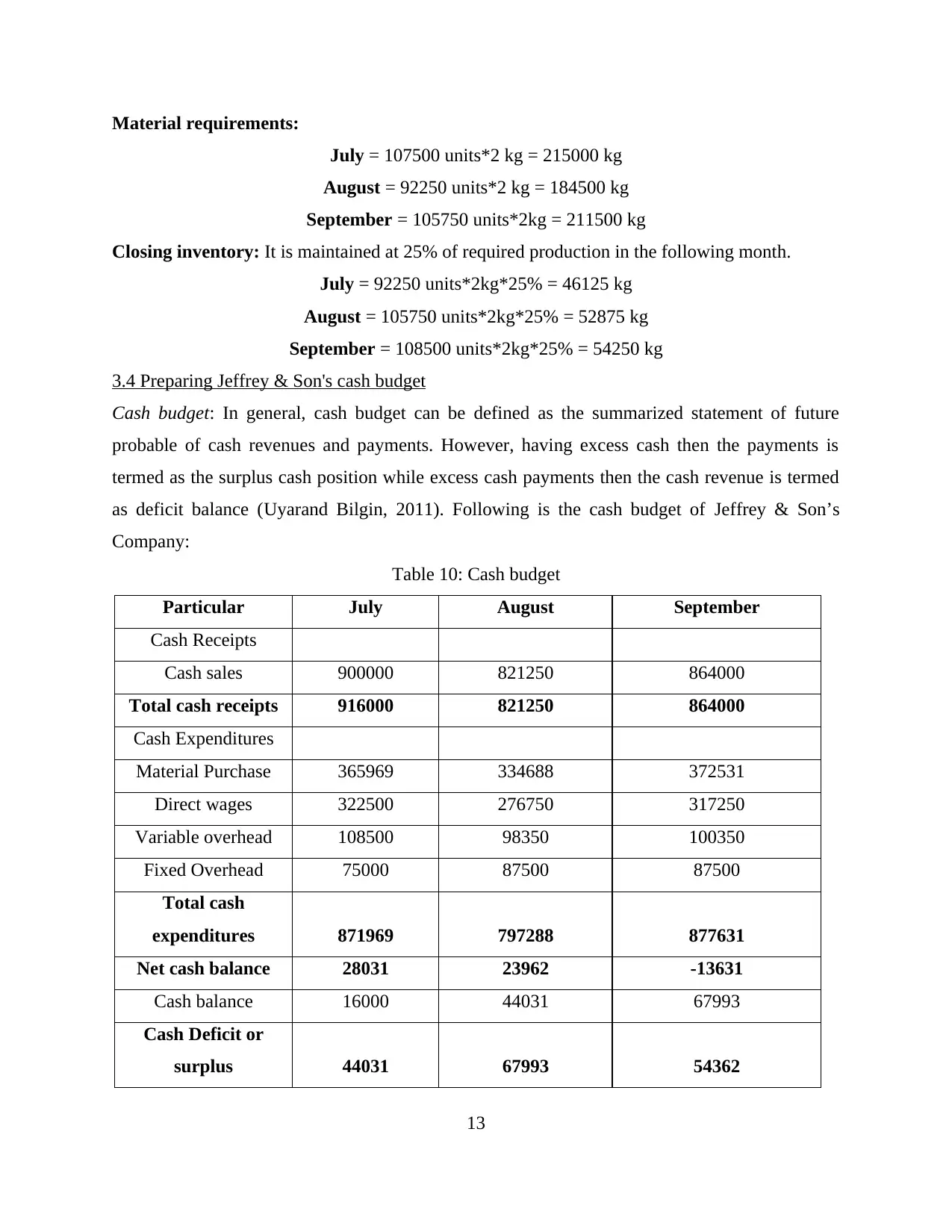
Material requirements:
July = 107500 units*2 kg = 215000 kg
August = 92250 units*2 kg = 184500 kg
September = 105750 units*2kg = 211500 kg
Closing inventory: It is maintained at 25% of required production in the following month.
July = 92250 units*2kg*25% = 46125 kg
August = 105750 units*2kg*25% = 52875 kg
September = 108500 units*2kg*25% = 54250 kg
3.4 Preparing Jeffrey & Son's cash budget
Cash budget: In general, cash budget can be defined as the summarized statement of future
probable of cash revenues and payments. However, having excess cash then the payments is
termed as the surplus cash position while excess cash payments then the cash revenue is termed
as deficit balance (Uyarand Bilgin, 2011). Following is the cash budget of Jeffrey & Son’s
Company:
Table 10: Cash budget
Particular July August September
Cash Receipts
Cash sales 900000 821250 864000
Total cash receipts 916000 821250 864000
Cash Expenditures
Material Purchase 365969 334688 372531
Direct wages 322500 276750 317250
Variable overhead 108500 98350 100350
Fixed Overhead 75000 87500 87500
Total cash
expenditures 871969 797288 877631
Net cash balance 28031 23962 -13631
Cash balance 16000 44031 67993
Cash Deficit or
surplus 44031 67993 54362
13
July = 107500 units*2 kg = 215000 kg
August = 92250 units*2 kg = 184500 kg
September = 105750 units*2kg = 211500 kg
Closing inventory: It is maintained at 25% of required production in the following month.
July = 92250 units*2kg*25% = 46125 kg
August = 105750 units*2kg*25% = 52875 kg
September = 108500 units*2kg*25% = 54250 kg
3.4 Preparing Jeffrey & Son's cash budget
Cash budget: In general, cash budget can be defined as the summarized statement of future
probable of cash revenues and payments. However, having excess cash then the payments is
termed as the surplus cash position while excess cash payments then the cash revenue is termed
as deficit balance (Uyarand Bilgin, 2011). Following is the cash budget of Jeffrey & Son’s
Company:
Table 10: Cash budget
Particular July August September
Cash Receipts
Cash sales 900000 821250 864000
Total cash receipts 916000 821250 864000
Cash Expenditures
Material Purchase 365969 334688 372531
Direct wages 322500 276750 317250
Variable overhead 108500 98350 100350
Fixed Overhead 75000 87500 87500
Total cash
expenditures 871969 797288 877631
Net cash balance 28031 23962 -13631
Cash balance 16000 44031 67993
Cash Deficit or
surplus 44031 67993 54362
13
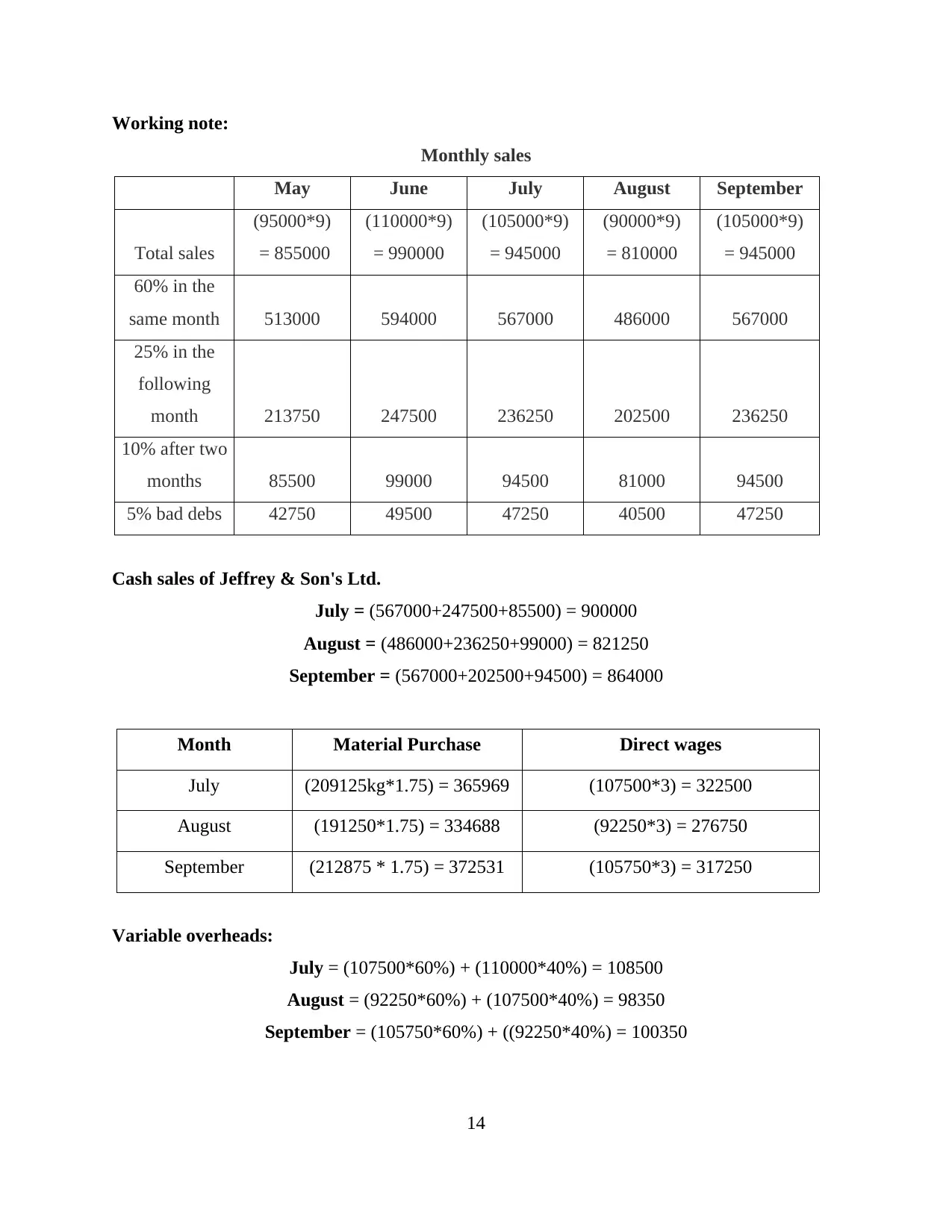
Working note:
Monthly sales
May June July August September
Total sales
(95000*9)
= 855000
(110000*9)
= 990000
(105000*9)
= 945000
(90000*9)
= 810000
(105000*9)
= 945000
60% in the
same month 513000 594000 567000 486000 567000
25% in the
following
month 213750 247500 236250 202500 236250
10% after two
months 85500 99000 94500 81000 94500
5% bad debs 42750 49500 47250 40500 47250
Cash sales of Jeffrey & Son's Ltd.
July = (567000+247500+85500) = 900000
August = (486000+236250+99000) = 821250
September = (567000+202500+94500) = 864000
Month Material Purchase Direct wages
July (209125kg*1.75) = 365969 (107500*3) = 322500
August (191250*1.75) = 334688 (92250*3) = 276750
September (212875 * 1.75) = 372531 (105750*3) = 317250
Variable overheads:
July = (107500*60%) + (110000*40%) = 108500
August = (92250*60%) + (107500*40%) = 98350
September = (105750*60%) + ((92250*40%) = 100350
14
Monthly sales
May June July August September
Total sales
(95000*9)
= 855000
(110000*9)
= 990000
(105000*9)
= 945000
(90000*9)
= 810000
(105000*9)
= 945000
60% in the
same month 513000 594000 567000 486000 567000
25% in the
following
month 213750 247500 236250 202500 236250
10% after two
months 85500 99000 94500 81000 94500
5% bad debs 42750 49500 47250 40500 47250
Cash sales of Jeffrey & Son's Ltd.
July = (567000+247500+85500) = 900000
August = (486000+236250+99000) = 821250
September = (567000+202500+94500) = 864000
Month Material Purchase Direct wages
July (209125kg*1.75) = 365969 (107500*3) = 322500
August (191250*1.75) = 334688 (92250*3) = 276750
September (212875 * 1.75) = 372531 (105750*3) = 317250
Variable overheads:
July = (107500*60%) + (110000*40%) = 108500
August = (92250*60%) + (107500*40%) = 98350
September = (105750*60%) + ((92250*40%) = 100350
14
Paraphrase This Document
Need a fresh take? Get an instant paraphrase of this document with our AI Paraphraser
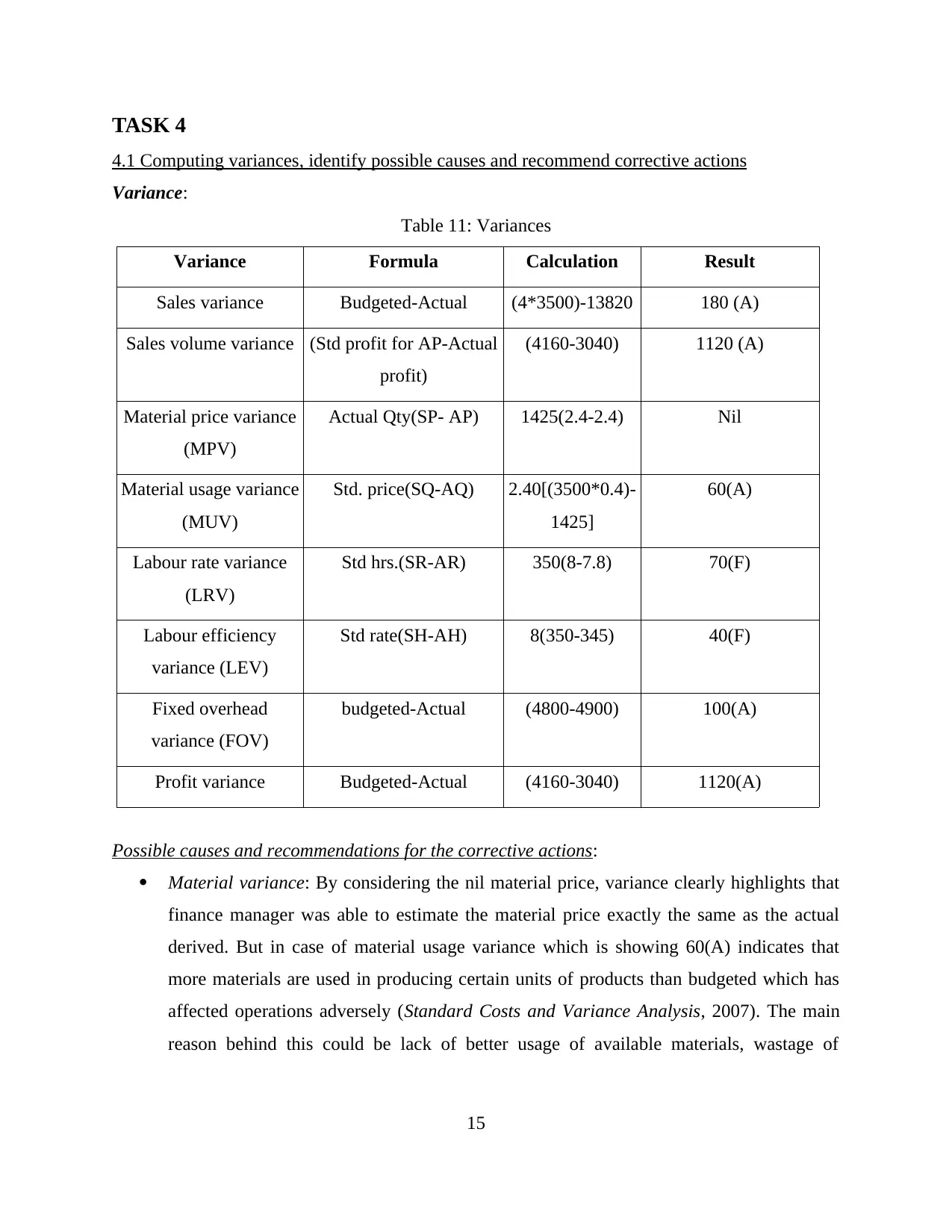
TASK 4
4.1 Computing variances, identify possible causes and recommend corrective actions
Variance:
Table 11: Variances
Variance Formula Calculation Result
Sales variance Budgeted-Actual (4*3500)-13820 180 (A)
Sales volume variance (Std profit for AP-Actual
profit)
(4160-3040) 1120 (A)
Material price variance
(MPV)
Actual Qty(SP- AP) 1425(2.4-2.4) Nil
Material usage variance
(MUV)
Std. price(SQ-AQ) 2.40[(3500*0.4)-
1425]
60(A)
Labour rate variance
(LRV)
Std hrs.(SR-AR) 350(8-7.8) 70(F)
Labour efficiency
variance (LEV)
Std rate(SH-AH) 8(350-345) 40(F)
Fixed overhead
variance (FOV)
budgeted-Actual (4800-4900) 100(A)
Profit variance Budgeted-Actual (4160-3040) 1120(A)
Possible causes and recommendations for the corrective actions:
Material variance: By considering the nil material price, variance clearly highlights that
finance manager was able to estimate the material price exactly the same as the actual
derived. But in case of material usage variance which is showing 60(A) indicates that
more materials are used in producing certain units of products than budgeted which has
affected operations adversely (Standard Costs and Variance Analysis, 2007). The main
reason behind this could be lack of better usage of available materials, wastage of
15
4.1 Computing variances, identify possible causes and recommend corrective actions
Variance:
Table 11: Variances
Variance Formula Calculation Result
Sales variance Budgeted-Actual (4*3500)-13820 180 (A)
Sales volume variance (Std profit for AP-Actual
profit)
(4160-3040) 1120 (A)
Material price variance
(MPV)
Actual Qty(SP- AP) 1425(2.4-2.4) Nil
Material usage variance
(MUV)
Std. price(SQ-AQ) 2.40[(3500*0.4)-
1425]
60(A)
Labour rate variance
(LRV)
Std hrs.(SR-AR) 350(8-7.8) 70(F)
Labour efficiency
variance (LEV)
Std rate(SH-AH) 8(350-345) 40(F)
Fixed overhead
variance (FOV)
budgeted-Actual (4800-4900) 100(A)
Profit variance Budgeted-Actual (4160-3040) 1120(A)
Possible causes and recommendations for the corrective actions:
Material variance: By considering the nil material price, variance clearly highlights that
finance manager was able to estimate the material price exactly the same as the actual
derived. But in case of material usage variance which is showing 60(A) indicates that
more materials are used in producing certain units of products than budgeted which has
affected operations adversely (Standard Costs and Variance Analysis, 2007). The main
reason behind this could be lack of better usage of available materials, wastage of
15

materials or the poor material management. In order to overcome, Jeffrey & Son’s can
use effective material management practices and policies.
Labour variance: Herein, both labour rate and efficiency variances are showing
favourable results. This clearly indicates that top level management is managing its
troops in an appropriate ways.
Sales and profit variance: Due to lower sales, prices and sales volumes lead to generate
adverse sales variance of 180(A). Management can increase price of product and remove
adverse variance from sales. On the other hand, negative profit variance of 1120 indicates
that lower sales leads to generate lower profits.
4.2 Operating Statement
Table 12: Operating statement
Cost variances Type Favorable (In £) Adverse (In £)
Net variance
(In £)
Material Price 0
Usage 60 60(A)
Labour Rate 70 70(F)
Usage 40 40(F)
Fixed overhead variance 100 100(A)
Sales price variance 180 180(A)
Sales volume variance 1120 1120(A)
Total 110 1460 1350(A)
Budgeted operating profit 4160
Less: Total net variance 1350(A)
Actual operating profit 2810
4.3 Responsibility canters
Responsibility centres of Jeffrey & Son’s focuses on indulging in potential measures
regarding the adverse variance so that operational performance of business can be improved. The
cost centre focuses on controlling the expenditure or costs of the produced products. From the
16
use effective material management practices and policies.
Labour variance: Herein, both labour rate and efficiency variances are showing
favourable results. This clearly indicates that top level management is managing its
troops in an appropriate ways.
Sales and profit variance: Due to lower sales, prices and sales volumes lead to generate
adverse sales variance of 180(A). Management can increase price of product and remove
adverse variance from sales. On the other hand, negative profit variance of 1120 indicates
that lower sales leads to generate lower profits.
4.2 Operating Statement
Table 12: Operating statement
Cost variances Type Favorable (In £) Adverse (In £)
Net variance
(In £)
Material Price 0
Usage 60 60(A)
Labour Rate 70 70(F)
Usage 40 40(F)
Fixed overhead variance 100 100(A)
Sales price variance 180 180(A)
Sales volume variance 1120 1120(A)
Total 110 1460 1350(A)
Budgeted operating profit 4160
Less: Total net variance 1350(A)
Actual operating profit 2810
4.3 Responsibility canters
Responsibility centres of Jeffrey & Son’s focuses on indulging in potential measures
regarding the adverse variance so that operational performance of business can be improved. The
cost centre focuses on controlling the expenditure or costs of the produced products. From the
16
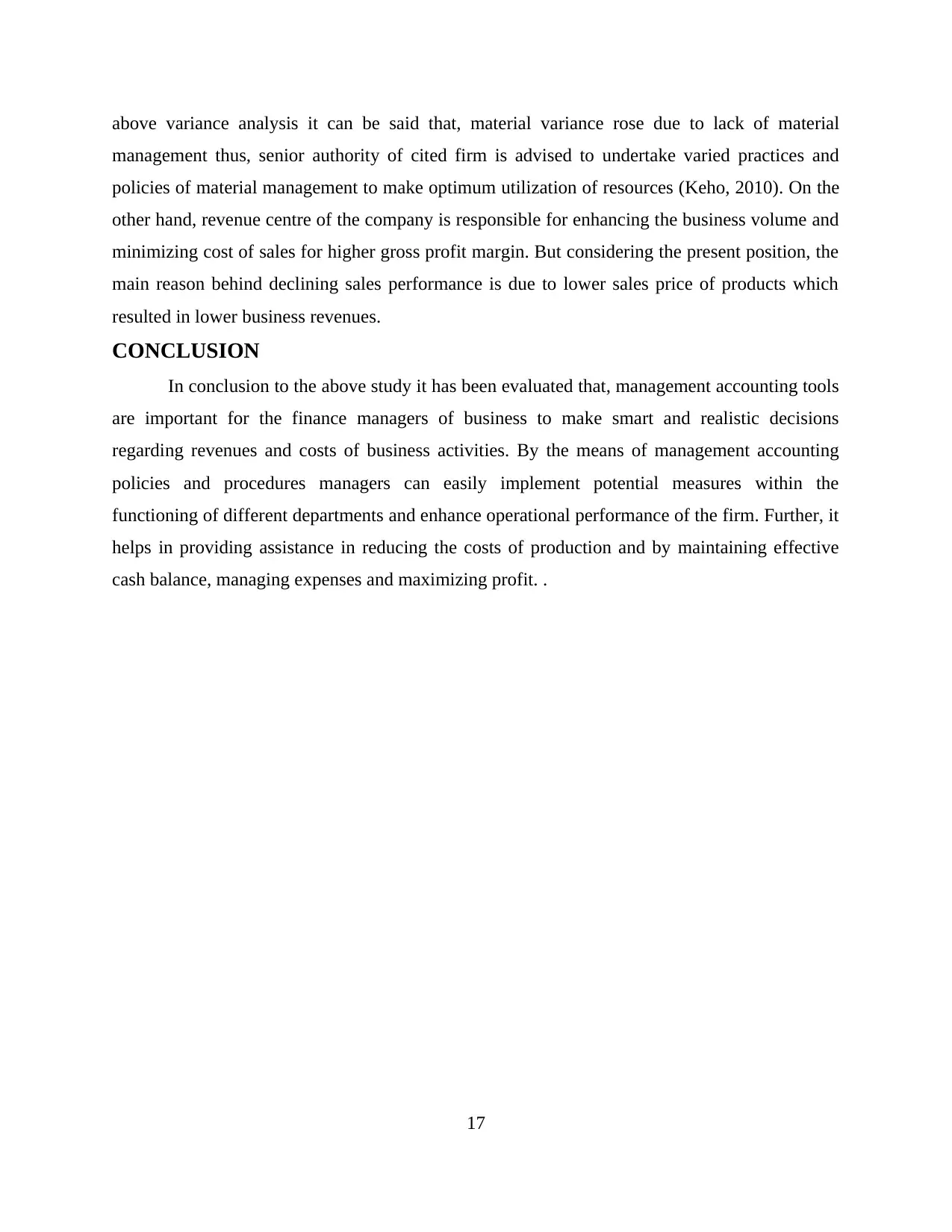
above variance analysis it can be said that, material variance rose due to lack of material
management thus, senior authority of cited firm is advised to undertake varied practices and
policies of material management to make optimum utilization of resources (Keho, 2010). On the
other hand, revenue centre of the company is responsible for enhancing the business volume and
minimizing cost of sales for higher gross profit margin. But considering the present position, the
main reason behind declining sales performance is due to lower sales price of products which
resulted in lower business revenues.
CONCLUSION
In conclusion to the above study it has been evaluated that, management accounting tools
are important for the finance managers of business to make smart and realistic decisions
regarding revenues and costs of business activities. By the means of management accounting
policies and procedures managers can easily implement potential measures within the
functioning of different departments and enhance operational performance of the firm. Further, it
helps in providing assistance in reducing the costs of production and by maintaining effective
cash balance, managing expenses and maximizing profit. .
17
management thus, senior authority of cited firm is advised to undertake varied practices and
policies of material management to make optimum utilization of resources (Keho, 2010). On the
other hand, revenue centre of the company is responsible for enhancing the business volume and
minimizing cost of sales for higher gross profit margin. But considering the present position, the
main reason behind declining sales performance is due to lower sales price of products which
resulted in lower business revenues.
CONCLUSION
In conclusion to the above study it has been evaluated that, management accounting tools
are important for the finance managers of business to make smart and realistic decisions
regarding revenues and costs of business activities. By the means of management accounting
policies and procedures managers can easily implement potential measures within the
functioning of different departments and enhance operational performance of the firm. Further, it
helps in providing assistance in reducing the costs of production and by maintaining effective
cash balance, managing expenses and maximizing profit. .
17
Secure Best Marks with AI Grader
Need help grading? Try our AI Grader for instant feedback on your assignments.
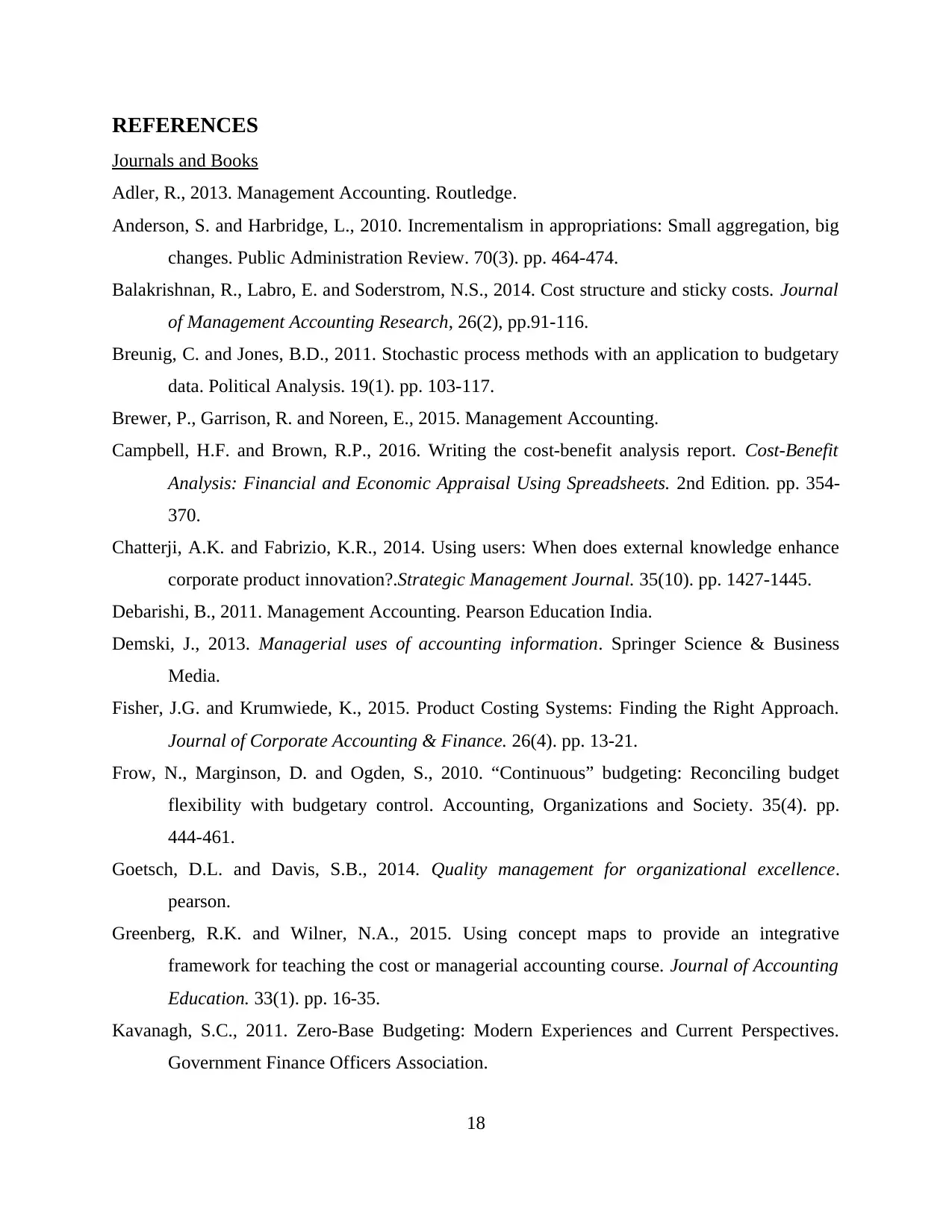
REFERENCES
Journals and Books
Adler, R., 2013. Management Accounting. Routledge.
Anderson, S. and Harbridge, L., 2010. Incrementalism in appropriations: Small aggregation, big
changes. Public Administration Review. 70(3). pp. 464-474.
Balakrishnan, R., Labro, E. and Soderstrom, N.S., 2014. Cost structure and sticky costs. Journal
of Management Accounting Research, 26(2), pp.91-116.
Breunig, C. and Jones, B.D., 2011. Stochastic process methods with an application to budgetary
data. Political Analysis. 19(1). pp. 103-117.
Brewer, P., Garrison, R. and Noreen, E., 2015. Management Accounting.
Campbell, H.F. and Brown, R.P., 2016. Writing the cost-benefit analysis report. Cost-Benefit
Analysis: Financial and Economic Appraisal Using Spreadsheets. 2nd Edition. pp. 354-
370.
Chatterji, A.K. and Fabrizio, K.R., 2014. Using users: When does external knowledge enhance
corporate product innovation?.Strategic Management Journal. 35(10). pp. 1427-1445.
Debarishi, B., 2011. Management Accounting. Pearson Education India.
Demski, J., 2013. Managerial uses of accounting information. Springer Science & Business
Media.
Fisher, J.G. and Krumwiede, K., 2015. Product Costing Systems: Finding the Right Approach.
Journal of Corporate Accounting & Finance. 26(4). pp. 13-21.
Frow, N., Marginson, D. and Ogden, S., 2010. “Continuous” budgeting: Reconciling budget
flexibility with budgetary control. Accounting, Organizations and Society. 35(4). pp.
444-461.
Goetsch, D.L. and Davis, S.B., 2014. Quality management for organizational excellence.
pearson.
Greenberg, R.K. and Wilner, N.A., 2015. Using concept maps to provide an integrative
framework for teaching the cost or managerial accounting course. Journal of Accounting
Education. 33(1). pp. 16-35.
Kavanagh, S.C., 2011. Zero-Base Budgeting: Modern Experiences and Current Perspectives.
Government Finance Officers Association.
18
Journals and Books
Adler, R., 2013. Management Accounting. Routledge.
Anderson, S. and Harbridge, L., 2010. Incrementalism in appropriations: Small aggregation, big
changes. Public Administration Review. 70(3). pp. 464-474.
Balakrishnan, R., Labro, E. and Soderstrom, N.S., 2014. Cost structure and sticky costs. Journal
of Management Accounting Research, 26(2), pp.91-116.
Breunig, C. and Jones, B.D., 2011. Stochastic process methods with an application to budgetary
data. Political Analysis. 19(1). pp. 103-117.
Brewer, P., Garrison, R. and Noreen, E., 2015. Management Accounting.
Campbell, H.F. and Brown, R.P., 2016. Writing the cost-benefit analysis report. Cost-Benefit
Analysis: Financial and Economic Appraisal Using Spreadsheets. 2nd Edition. pp. 354-
370.
Chatterji, A.K. and Fabrizio, K.R., 2014. Using users: When does external knowledge enhance
corporate product innovation?.Strategic Management Journal. 35(10). pp. 1427-1445.
Debarishi, B., 2011. Management Accounting. Pearson Education India.
Demski, J., 2013. Managerial uses of accounting information. Springer Science & Business
Media.
Fisher, J.G. and Krumwiede, K., 2015. Product Costing Systems: Finding the Right Approach.
Journal of Corporate Accounting & Finance. 26(4). pp. 13-21.
Frow, N., Marginson, D. and Ogden, S., 2010. “Continuous” budgeting: Reconciling budget
flexibility with budgetary control. Accounting, Organizations and Society. 35(4). pp.
444-461.
Goetsch, D.L. and Davis, S.B., 2014. Quality management for organizational excellence.
pearson.
Greenberg, R.K. and Wilner, N.A., 2015. Using concept maps to provide an integrative
framework for teaching the cost or managerial accounting course. Journal of Accounting
Education. 33(1). pp. 16-35.
Kavanagh, S.C., 2011. Zero-Base Budgeting: Modern Experiences and Current Perspectives.
Government Finance Officers Association.
18
1 out of 20
Related Documents
Your All-in-One AI-Powered Toolkit for Academic Success.
+13062052269
info@desklib.com
Available 24*7 on WhatsApp / Email
![[object Object]](/_next/static/media/star-bottom.7253800d.svg)
Unlock your academic potential
© 2024 | Zucol Services PVT LTD | All rights reserved.





